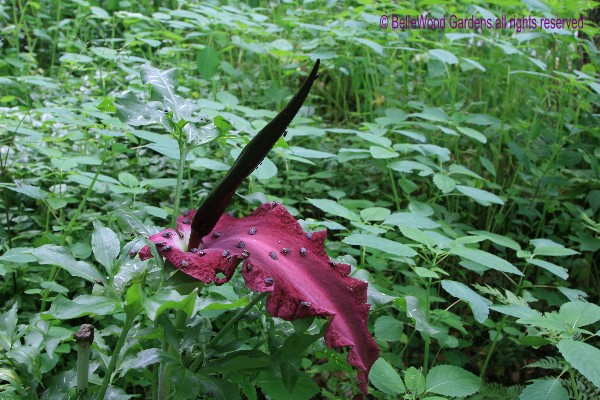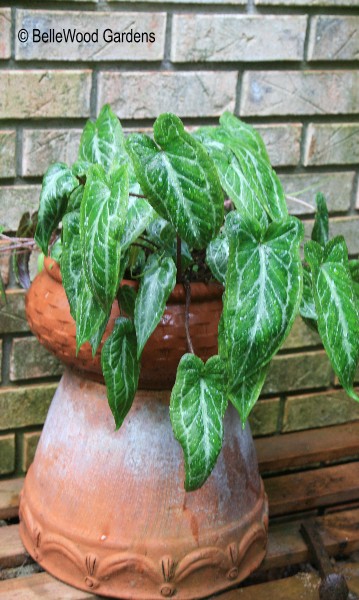| March | April | May | June |
| July | August | September | October |
October
Thursday, 8 October 2009
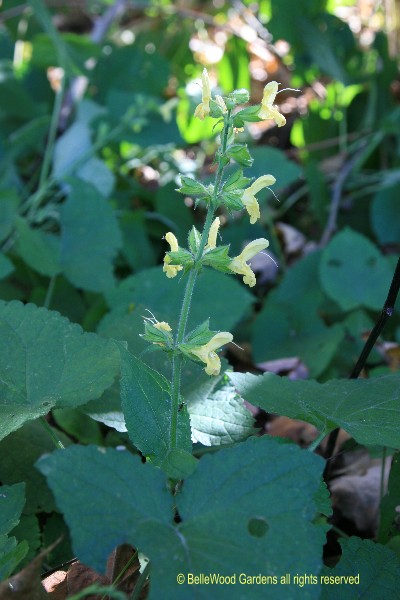
Salvia koyame is a pretty little salvia from Japan with much to reccommend it -
October flowering, shade tolerant, and - so far - not part of Bambi's salad bar.
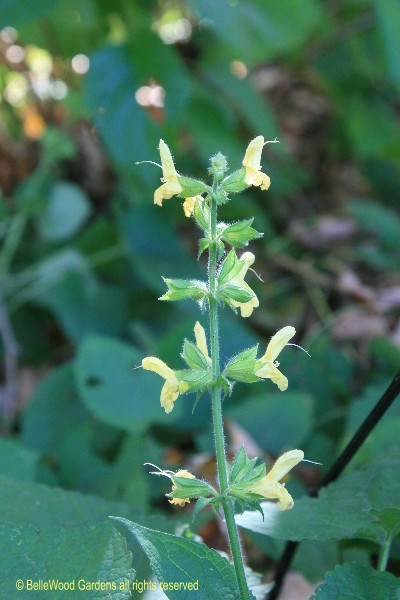
Sunday, 4 October 2009
Colchicum began to bloom last month. October has barely begun, I got back today from a brief trip to Delaware (lecturing on cultivating native Liliaceous plants for the Delaware native plant society) and discovered yet more colchicums in flower.
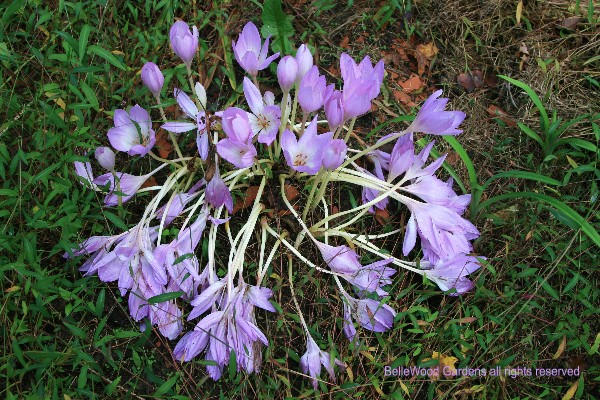
Colchicum speciosum is noted for its goblet-like flowers, accentuated by the white throat.
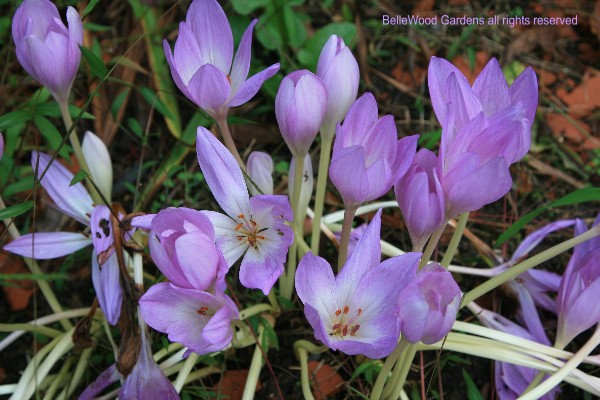
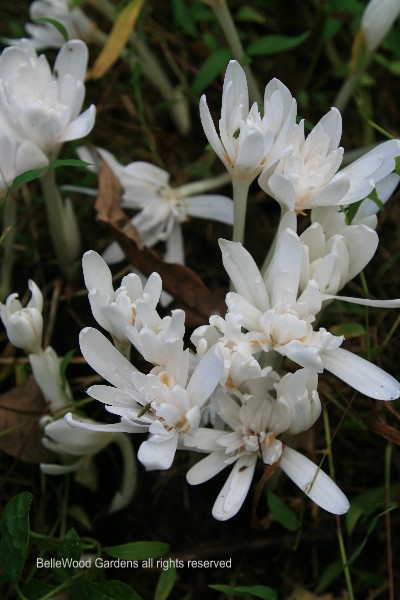
Colchicum autumnale 'Alboplenum' embellishes its double white flowers with
a scattering of stamens showing golden pollen.
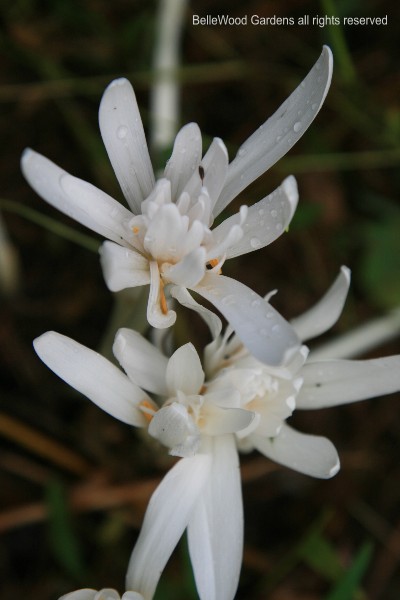
.
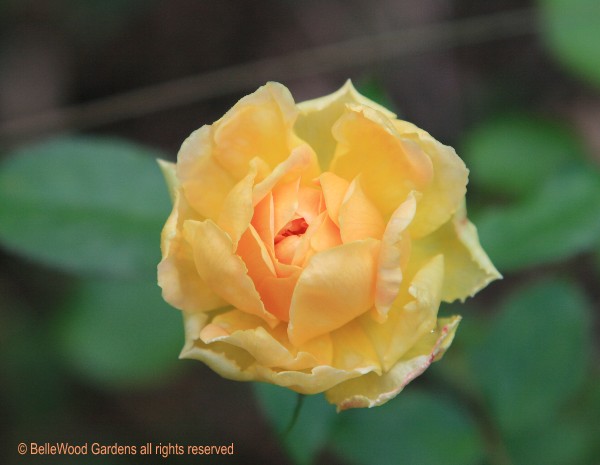
Autumn's roses are to be especially cherished. This glowing example
is the David Austin rose, 'Molineaux'.
.
I came home to find monkshood in bloom, right on schedule.
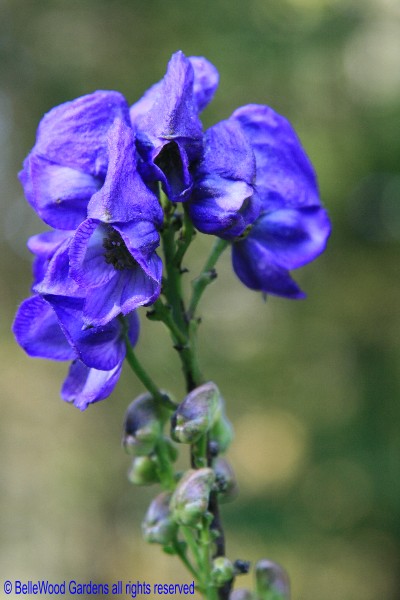
First, the rich blue-violet of Aconitum napellus
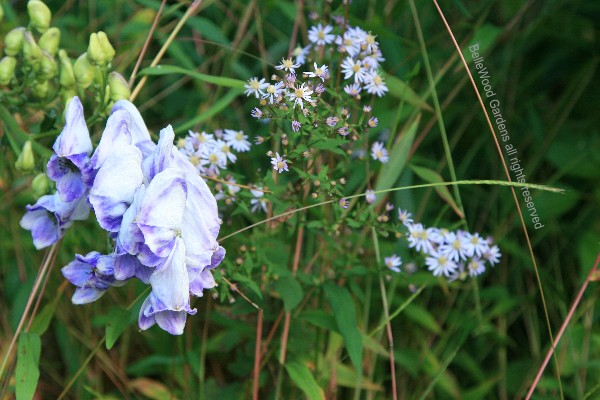
and also its paler counterpart Aconitum 'Cloudy', off-white flowers washed with blue-violet.
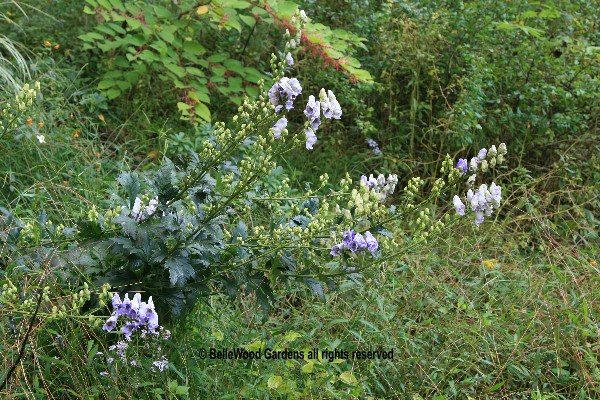
I bought these 3 plants just two years ago, in September 2007. Just look
at all the flower buds. What a display they'll provide this year, and safe
from deer with designs on my salad bar, I mean garden. Poisonous in
all part, the critters are prudent enough to leave monkshood alone.
September
Tuesday, 15 September 2009
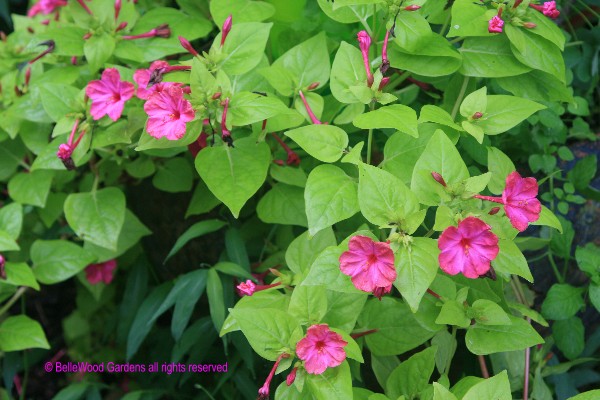
Mirabilis jalapa ex 'Limelight'. I collected the seed several years ago. Not only does this cultivar
with chartreuse leaves and fuchsia flowers come true from seed, so does the twice removed generation.
Four o'clock flowers the first year from seed, flowers summer into fall, and the tuberous roots are easily
kept over winter, simply by moving their pots into the garage where they're kept dry and downright chilly.
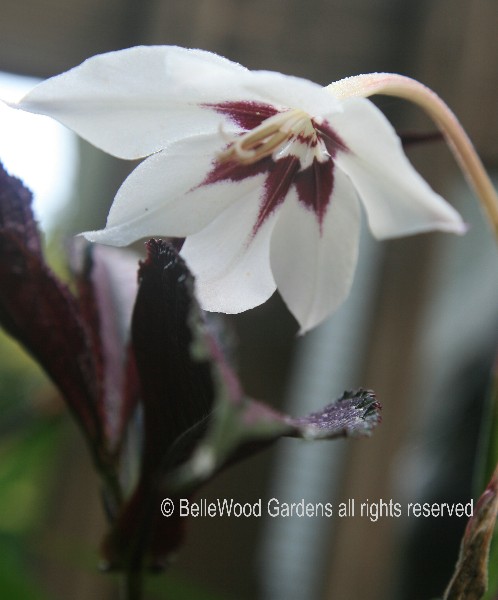
Taxonomists have tossed this charming corm around. Currently it resides in with gladiolus.
To be au courant, call it Gladiolus callianthus. But you still might find it in catalogues
under its old name of Acidanthera bicolor, or even Acidanthera murialae. Whatever.
Inexpensive enough that if you don't dig for winter storage, come Spring it's replaceable.
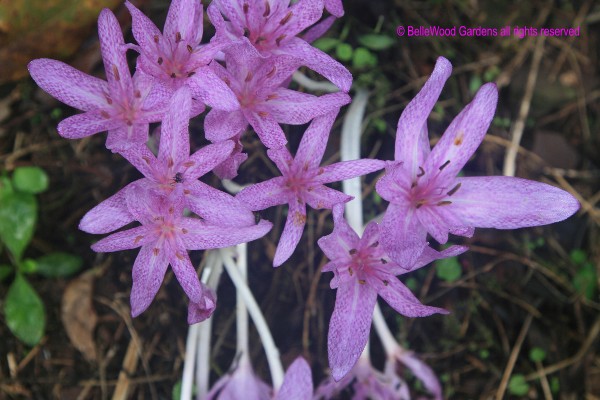
I am absolutely smitten with colchicum. They pop on the garden stage at summer's end
as the first leaves just begin to fall. Naked flowers like crocus on steroids emerge alone,
sans any leaves. From little mice to rabbits and even deer, the vermin all leave them alone.
And the flowers last a surprisingly long time when cut and brought indoors. Handsomely
marked with a pattern of chequering, this tessellated species is Colchicum agrippinum.
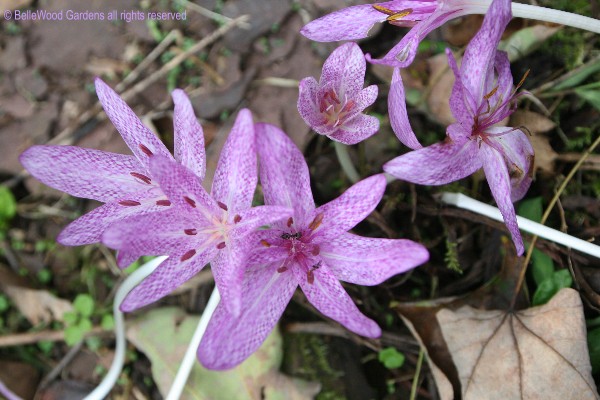
.
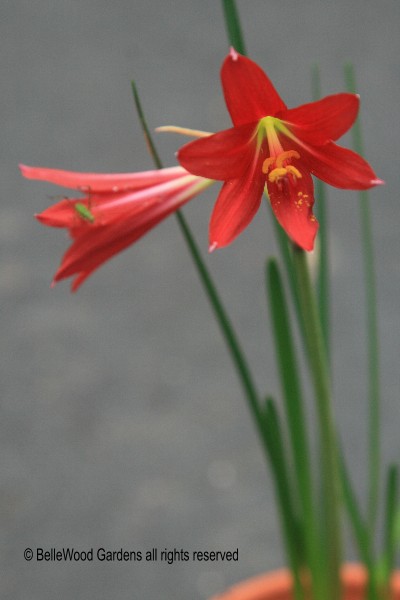
Oxblood lily, schoolhouse lily, Rhodophiala bifida is South American bulb
that thrives in Texas. Here in New Jersey I must keep it potted.
Tall pots, as the bulbs work their way down and down. Summers,
they bake in the greenhouse. End of summer I either top-dress or
repot, and set them outdoors to get rained on. Up pop the flowers
in response. When nights become chilly, back into the greenhouse.
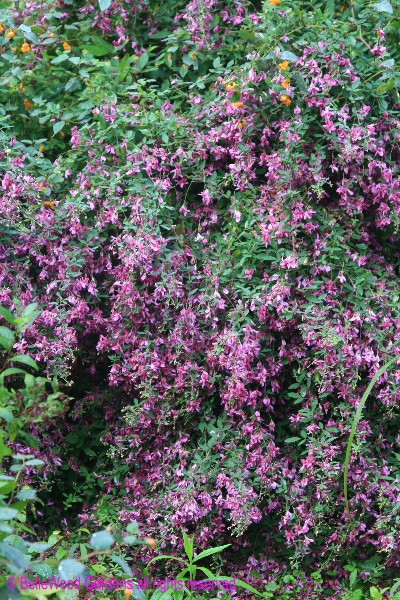
I treat bush clover as a cutback shrub. No idea what it would do if I did not,
but for sure the yearly display of softly arching branches clothed with masses
of vivid fuchsia flowers is ample reward for minimal effort on my part. This is
the cultivar Lespedeza thunbergii 'Gibraltar'. And it rocks in my garden.
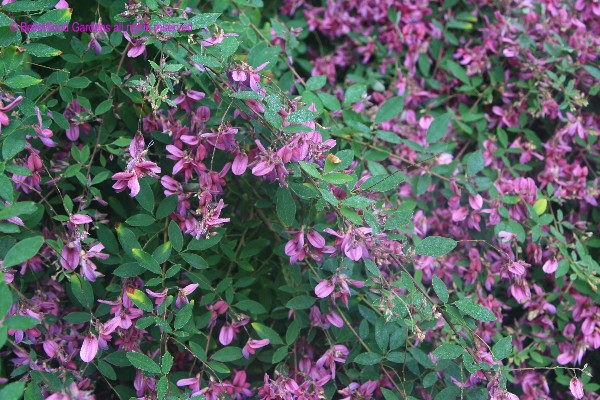
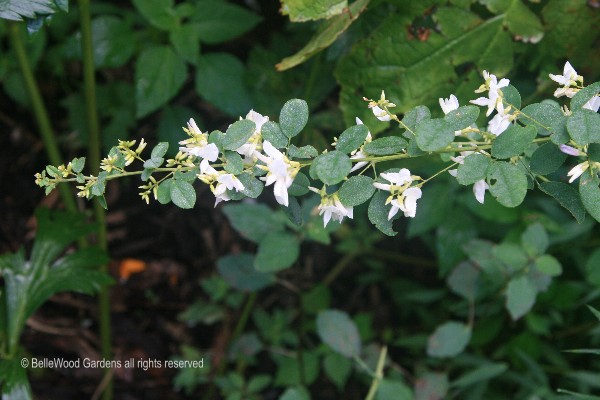
There's a white form also, Lespedeza thunbergii 'Alba' that comes into bloom just a little later.
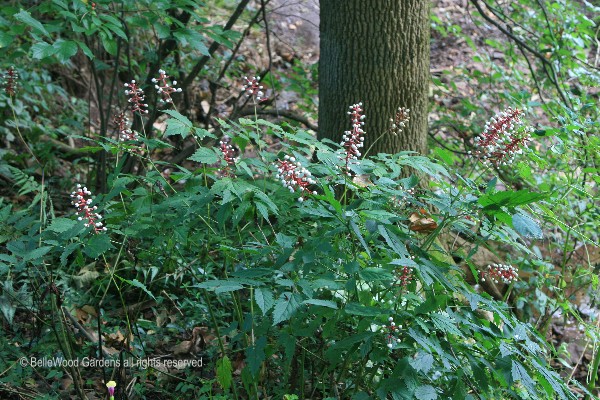
Nothing much in flower, somewhat reminiscent of a dumpy white astilbe. Doll's eyes stands out
in autumn, when its white berries, each marked with a single small black dot, are thought to
resemble the eyes of a china doll. This is another plant the taxonomists have renamed.
Now we're to call it Actaea alba, when before it was A. pachypoda, thick-footed actaea
for the sturdy pink pedicels that support each berry. Good thing the plants know who they are.
Friday, 7 August 2009 I am very fond of the green flowers of Nicotiana langsdorfii that volunteer
Thursday, 6 August 2009 No, this picture is not out of sequence. This azalea is indeed flowering in August.
The weeping fig with which we twice annually struggled up and down the stairs
Wednesday, 22 July 2009 Canna 'Pretoria' with Berberis thunbergii 'Aurea' Hemerocallis 'Bittersweet' .
Hemerocallis 'Heart of Africa' Setcreasea pallida 'Purple Heart' with dark leaved canna, Berberis thunbergii 'Atropurpurea' in background. Oxalis regnellii 'Atropurpurea' in foreground; Persian shield, Strobilanthes dyerianus in background;
Tuesday, 14 July 2009 Deinanthe bifida Agapanthus 'Peter Pan' Tuesday, July 7, 2009 Mirabilis ex 'Limelight'
Thursday, 25 June 2009 Tuesday, 23 June 2009 Monday, 8 June 2009 Wednesday, 3 June 2009
Thursday, 28 May 2009 Sunday, 24 May 2009 Yellow flag, Iris pseudacorus, is an adaptable non-native iris that happily grows
The tubers of Amorphophallus spent the winter in my garage, naked,
Fringe tree, Chionanthus virginica, is dioecious. That means that each tree
Friday, 22 May 2009 You have to brush the leaves aside to see the little tails of Arisarum probiscideum,
Some dead nettles are thugs, enthusiastically spreading far and wide.
Hybrid daylilies surge into the marketplace with nearly the profusion of hosta.
Gardens everywhere are filled with azaleas and rhododendrons: fuchsia,
Wednesday, 20 May 2009 The froth of tiny white flowers are pretty enough. However the reason I was eager
Enkianthus campanulatus dangles these pink-striped bells in profusion.
Every novice gardener homes in on flowers. Which is terrific while the plants
Someone was asking me about the purple flowers she'd seen blooming
Last week Allium 'Purple Sensation' was just opening.
Wednesday, 13 May 2009 When we moved here 15 years ago my friend Sally Ferguson of the
Plants have more to offer us than just their flowers. These dumpy white
Von Siebold was one of the physicians for the Dutch East Indies Corporation
.
As I walked around BelleWood Gardens earlier this morning I came across this plant
Monday, 11 May 2009 Parrot tulips are these lusciously extravagant blowsy flowers with snipped edge petals.
This charming dwarf peony, early into bloom, is 'Early Scout'. Finely textured foliage
Rhododendron yakusimanum has chamois-like fuzz on the underside
Most flowering quince have brick red flowers. 'Cameo' has, instead, blossoms
Another bulb, this time native to the Pacific Northwest. Sacajawea taught
This picture does not do justice to the flowers of Tulipa hageri splendens,
Saturday, 2 May 2009 It is that marvellous time of year when plants hurl themselves into bloom. Stroll around the garden in the morning, again around lunchtime, and in the warm light of evening. There's something new to see each time.
Vinca, also known as myrtle, is one of the big three of evergreen groundcovers.
UPDATE: A correction arrived from Kevin McGowen, customer service
Primula kisoana is a wonderful choice. It spreads vigorously by means
Cole Burrell, native plant maven, is so fond of epimedium that he declared them
I'm fond of peonies - attractive new shoots, great flowers, nice foliage
Trillium are the epitome of native woodland wildflowers. Easy to recognize,
Trillium and arisaema are native to North America and also Japan and China. We have
.
Nihei Takeo, my Japanese friend, once told me that yaburegasa,
UPDATE: Just to be sure I did not misremember, I asked Kiki. She said,
Sunday, 26 April 2009 An absurd change in the weather. The forecast is more like August than April. Today's temperatures are supposed to reach the high 80s Fahrenheit, and repeat again tomorrow, and on Monday, and on Tuesday. So reasonably early this morning I darted out of the house, camera in hand, before the heat could fry tender blossoms. Which it did, in several instances.
Hyacinths fresh from Holland have stout stems packed with flowers.
Narcissus poeticus is one of my favorites. The species is so preponderant
.
Fritillaria imperialis, crown imperial is very happy here at BelleWood Gardens.
.
Guinea hen flower, Fritillaria meleagris, is satisfied with edge of woodland.
Native wildflowers are making an appearance, both geophytic (bulbous,
Trillium, it goes without saying, are wildflowers we all adore. Who could resist
This charming combination of a sessile trillium with squirrel corn, Dicentra canadensis, pleases me each Spring. Another sessile trillium with copper-hued flowers, back-lit by morning sun. Lovely. Friday, 17 April 2009 Narcissus cyclamineus has strongly reflexed petals, a characteristic
If my plants could talk I'm sure they'd complain, something along the lines of
.
Some years ago there was an eager infatuation with blue flowered corydalis.
Friday, 10 April 2009 Asian twinleaf, Jeffersonia dubia, is native to South Korea, eastern Russia, China,
A pleasing combination of deep plum-colored Helleborus × orientalis and
.
Hellebores self-sow here at BelleWood Gardens. I especially like this volunteer
The Christmas roses, Helleborus niger, also seed about. I've learned that it is best
.
Lungwort, Pulmonaria saccharata, is an excellent plant for shady gardens.
The first native plants are making an appearance on the forest floor.
Both common and Latin names - bloodroot, Sanguinaria canadensis,
Named dog-toothed violet for the shape of their underground bulbs, here's
This charming little daffodil moved with me from Connecticut. The label
Spring brings the blues. Not sadness, not when Spring cracks open winter's door.
Or the intensity of Scilla sibirica so luminous a shade that
There's another little scilla I'm fond of, two-leaved scilla, Scilla bifolia.
Woodies are getting into the act. Star magnolia, Magnolia stellata has
Saturday, 28 March 2009 Bulbocodium vernum is a brightly colored harbinger of Spring.
Thursday, 26 March 2009 Not a flower, far from it. Bambi's mother or aunt,
Wednesday, 25 March 2009 Galanthus nivalis 'Viridapice' is a variant snowdrop with charming green markings
Here's a beauty with a mystery about its identity. My nicely labeled assortment of snowdrops, a dozen or so different cultivars and species, underwent a flood event - heavy rains used the adjacent path as a new streambed. The dormant bulbs slept right through the excitement. However, their labels washed away. Now, snowdrops, in a number of instances, differ in rather small as opposed to really obvious details. Clearly this is a double. But just who is this pretty little flower
with a very tidy, fully double ruffled center and a few more than 3 outer petals? Could it be a Greatorex cultivar? Heyrick Greatorex (who died in 1954) crossed Galanthus nivalis 'Flore Pleno' with Galanthus plicatus in the 1940s, producing a range of vigorous, robust double flowered snowdrops which he named after female Shakespearean characters such as Desdemona and Ophelia. A reclusive man, he was apparently rather secretive about their details, and who is who has become rather muddled. Actually, I'm beginning to believe my pretty isn't a Greatorex double at all, but is instead Galanthus plicatus 'Hill Poë'. It was discovered around 1914 by James Hill Poë growing under a walnut tree near the dining room window at Riverston, in Ireland. Aaron P. Davis, in The Genus Galanthus (published by The Royal Botanic Gardens, Kew, in association with Timber Press in 1999) terms it "A really good, neat G. plicatus double." He goes on to say that it is "Easy to grow and reasonably fast to increase." I'll second that. The clump I dug to divide "in the green" on April 9 as the flowers were fading provided me with 34 divisions, and most are of flowering size.
Oh those taxonomists. This used to be named Scilla tubergeniana. Relatively easy
Though it flowers a couple of months later and has nothing to do with roses
Wednesday, 11 March 2009 Here we name them snowdrops. Schneeglocken, snowbells, in German,
While snowdrop variations are variations on a theme, close observation
Winter aconite, Eranthis hyemalis (or E. hiemalis) scatters coin-bright flowers
.
Here's a choice beauty: Eranthis pinnatifida from Japan. A friend there sent me
.
The first of the perennials are making their appearnces also.
Adonis amurensis is another sterile beauty. Great golden buttercup flowers
August
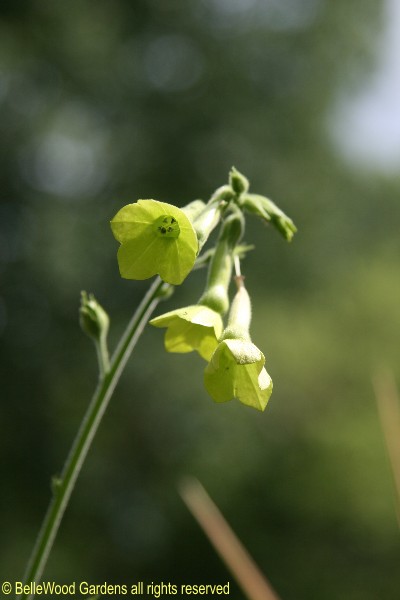
at BelleWood Gardens, happily showing up in the garden and even flower pots.
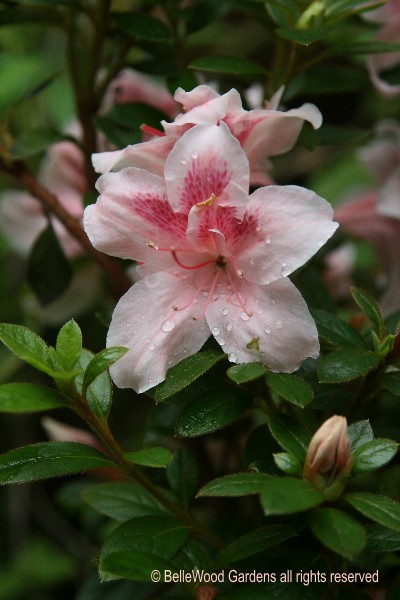
UPDATE It's now 28 September and I still have fresh flowers.
I'd seen these Encore Azalea® at a trade show, and early in April received some to trial.
Tidy dark green foliage on mounding plants, and azaleas that bloom, and bloom again.
This cultivar is 'Autumn Belle' and indeed, c'est très belle addition to BelleWood Gardens.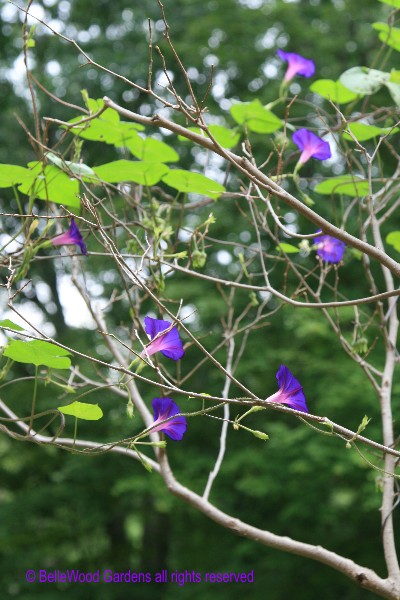
has finally died. Sorry to see it go, but hardly desolate. Temporarily, I decided
to use it as support for a couple of 'Grandpa Ott' morning glories, transplanting
the self-sown seedlings from where they'd volunteered. They're delightful!
I see them each morning as I come down stairs, a handful in bloom each day.
We'll move the pot around the corner and out of sight for winter, then reverse
next Spring, and glory my mornings all over again. What a pleasant silver lining.
July
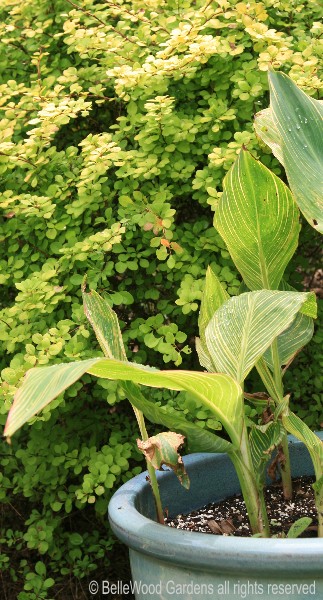
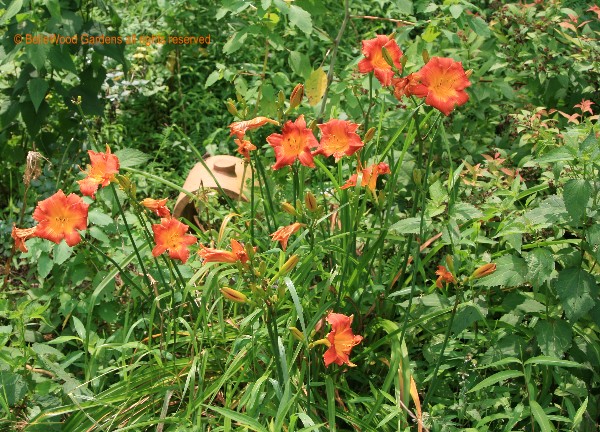
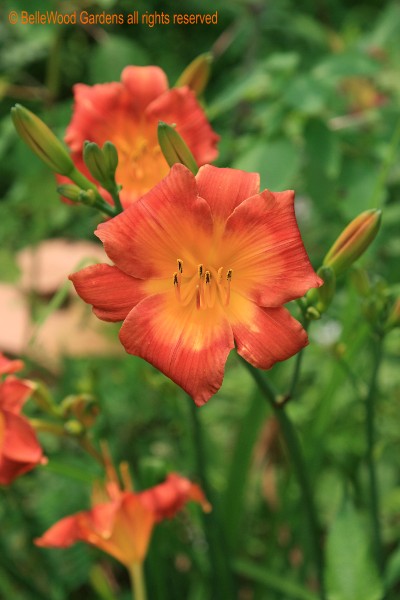
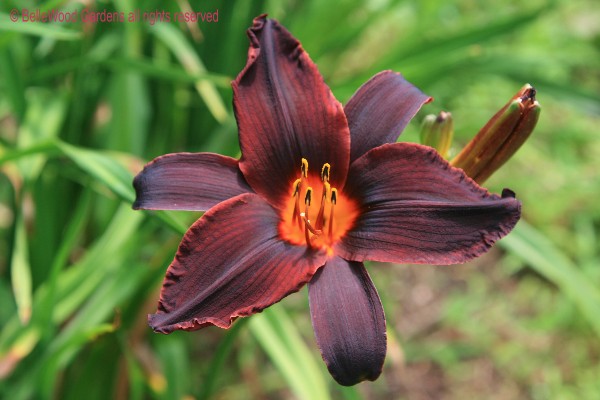
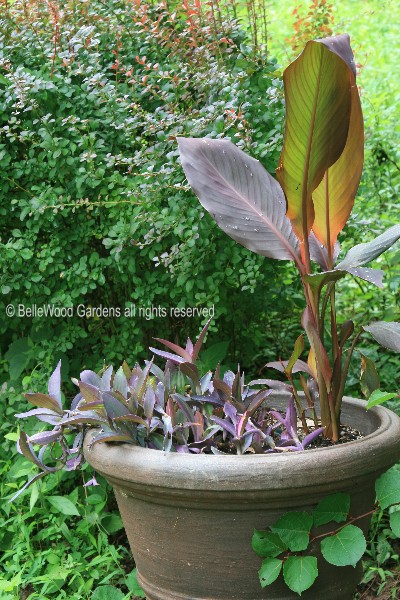
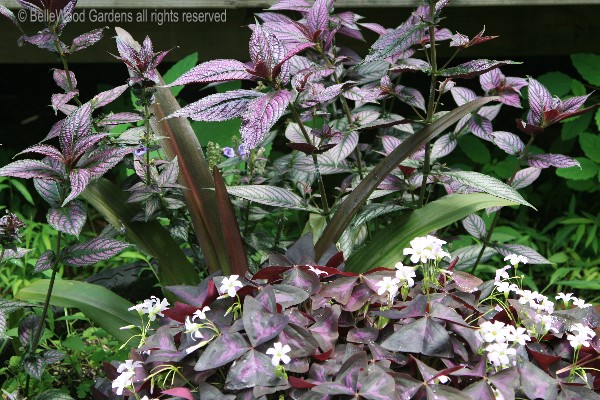
and purple-leaved Eucomis comosa 'Sparkling Burgundy' in the middle, not yet in flower.
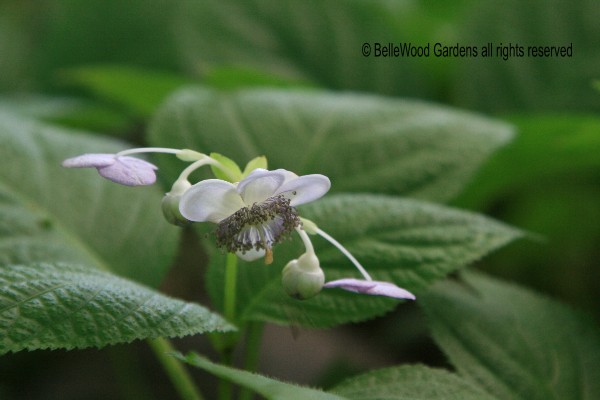
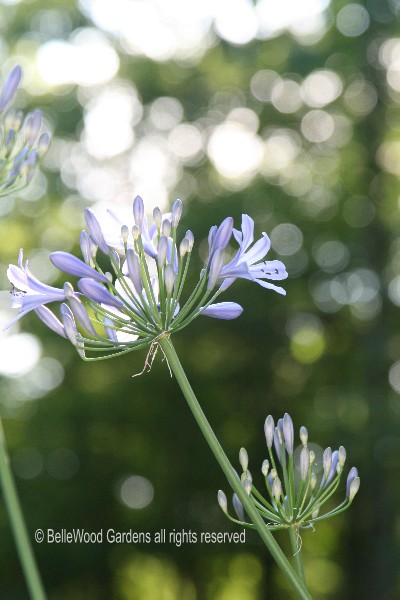
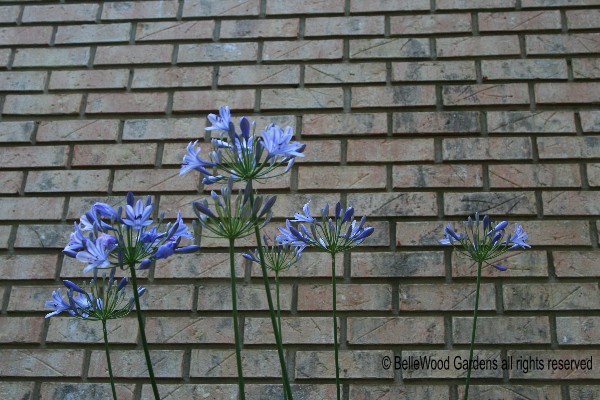
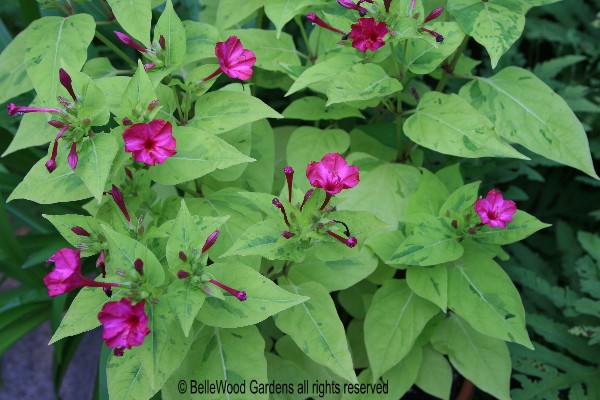
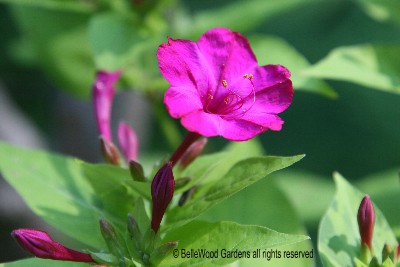
June
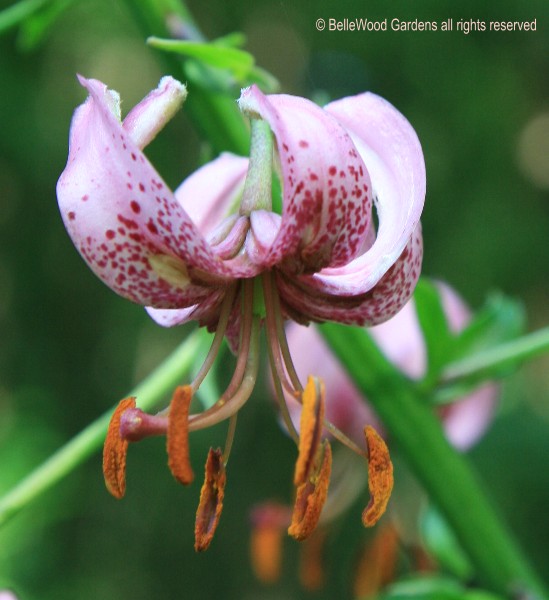
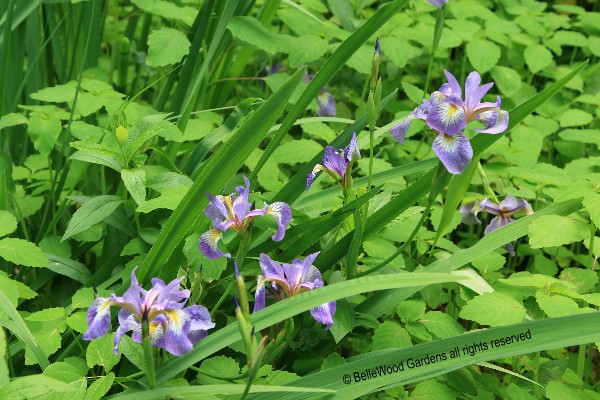
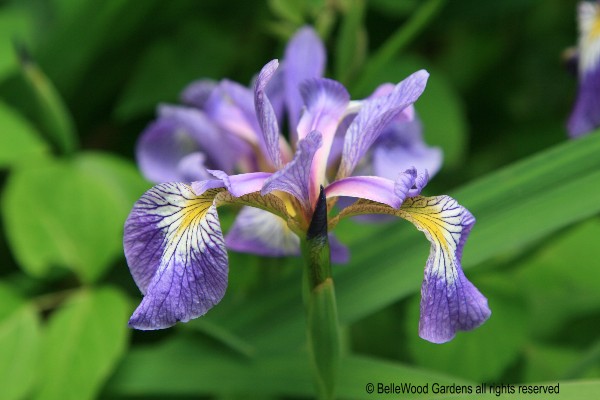
May
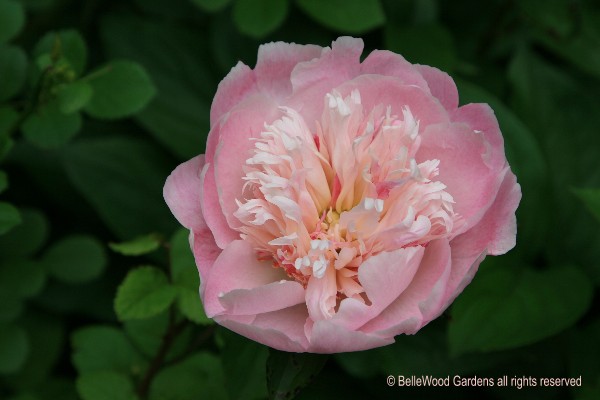
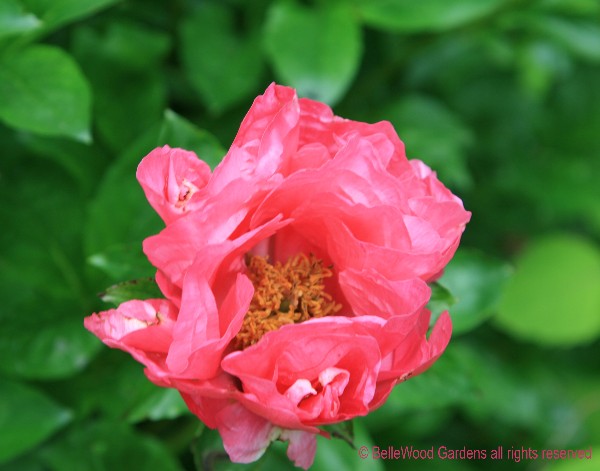
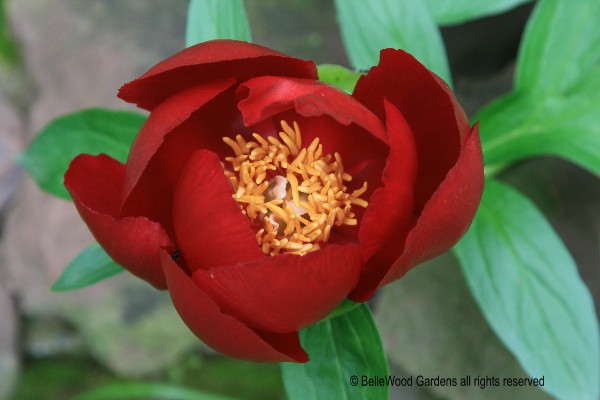
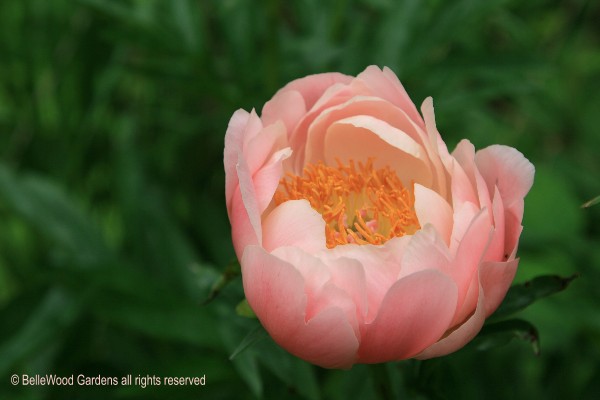
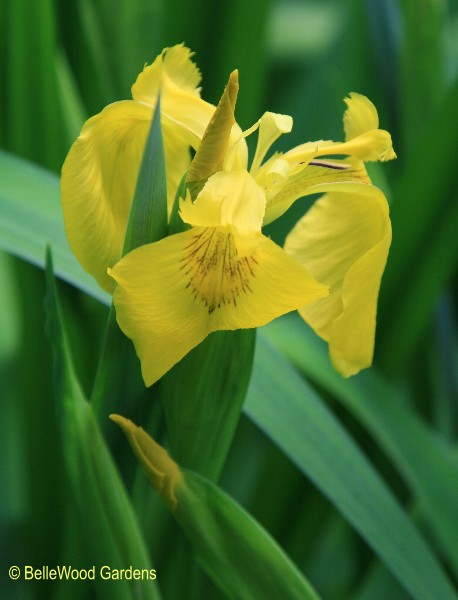
in shallow water, mucky soils, or average conditions. This facility has given it
a poor reputation, as an invasive species, since it can (and does) seed about.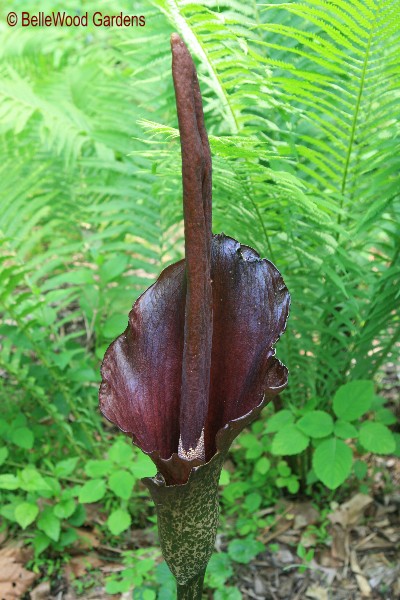
uncovered by any wisp of peat moss or scrap of newspaper. Planted
them out on 6 May, nearly 3 weeks ago. I was walking in the garden
today and smelled a stench that made me think something must have
crawled off and died. Nope. This, the largest tuber of the devil's tongue,
decided it was time to bloom. Pollinated by noxious flies that lay their eggs
on rotting corpses, it looks like dead meat. And smells like it too.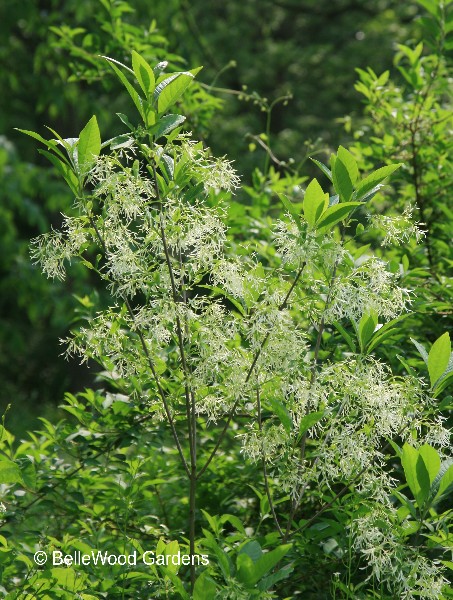
is either male or female. (You could, I suppose, call people dioecious.) There are
familiar plants that manage their sex life in this manner, hollies for example.
Big difference is that when you buy a holly you know which gender you are
purchasing. Not with fringe trees though. For whatever reason, nurseries don't
sex them. Females will have attractive, blue, dangling fruits. You do need both
for this to happen. Regardless, I'd suggest that you only purchase fringe trees
while in bloom. Otherwise it is all too easy to find that you have one which
scarcely blooms at all. And I do appreciate the flowers, and their fragrance.
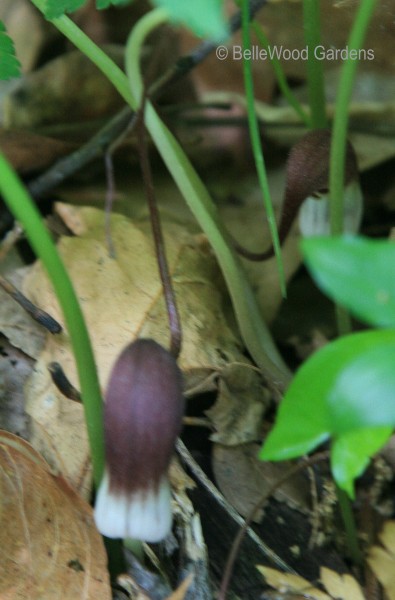
mouse tail arum. Native to Spain and Italy, the little tubers are perfectly hardy
here at BelleWood Gardens. Leaves emerge in April, go dormant in June.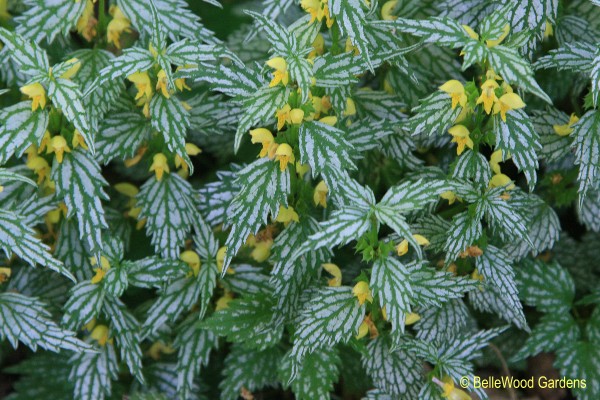
Lamiastrum 'Hermann' Pride' is a polite clump-forming plant
with attractive silver-netted leaves embellished with yellow flowers.
Easily propagated from stem cuttings. Note to self: make more.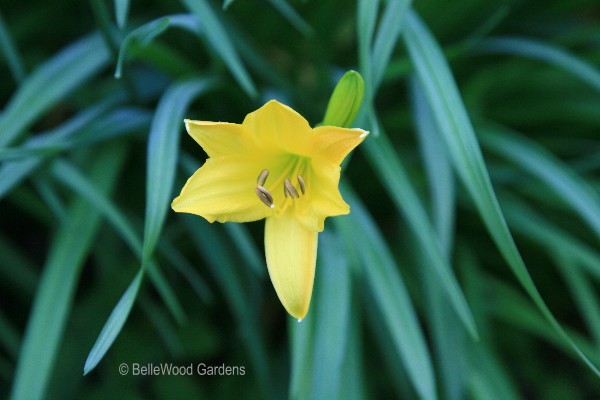
Me, I like the species. This small, early flowering charmer is now named
Hemerocallis lilio-asphodelus (formerly named H. flava.)
I collected it at an abandoned homestead along Route 7 in Connecticut,
wading through some poison ivy to get it. Worthwhile, as the species
are not as widely offered for sale as their elaborated cultivars. And,
as well as charming, these little yellow flowers are sweetly fragrant.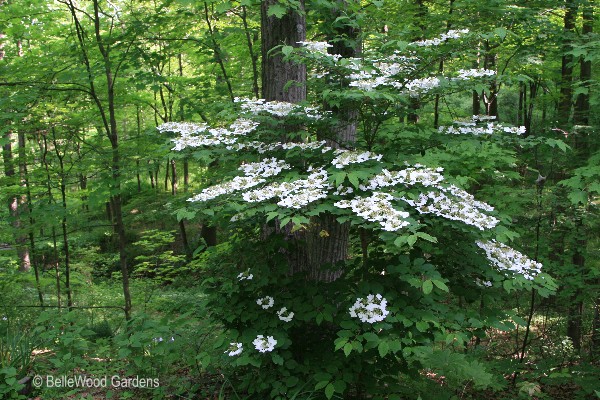
hot pink, purple or white. There are other shrubs that are now in bloom.
This is a favorite of mine, Viburnum plicatum 'Mariesii'. I like
its layered habit of growth and lacy mix of larger sterile and small fertile flowers.
An additional bonus- apparently the deer are uninterested in dining on it.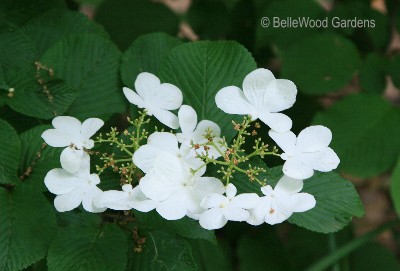
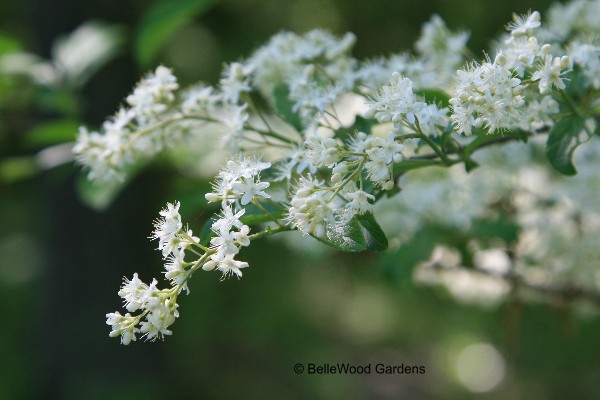
to acquire Symplocos paniculata is explained by its common name, sapphire berry.
In autumn the branches are laden with small bright blue berries, an elegant end to the season.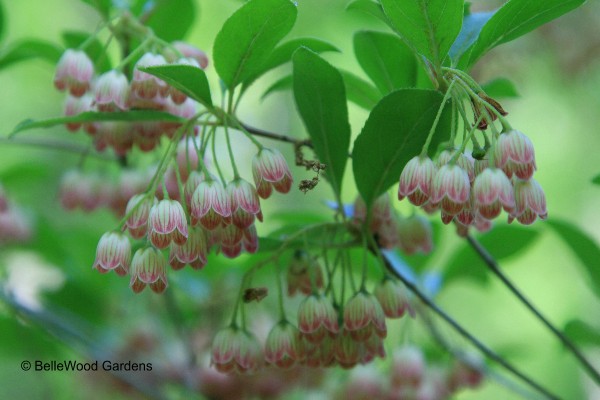
Another shrub that thrives in woodland shade, it makes an interesting alternative
to the ubiquitous azaleas, rhododendron, and pieris. Nothing wrong with them,
it is merely that I appreciate having alternatives from which to choose. Don't you?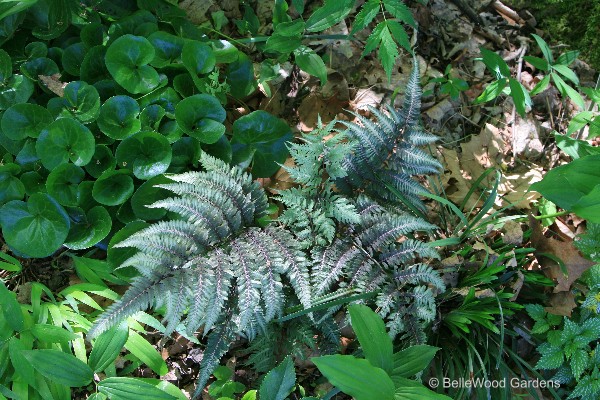
are in bloom, but what about when they're not? Especially in woodland gardens
where perennials tend to flower in Spring. That's why I often focus on foliage,
such as the exquisite silver fronds of Athyrium nipponicum 'Pictum',
Japanese painted fern. Interested? Read my book

Consider the Leaf: Foliage for Garden Design to learn more options,
possibilities, and garden-worthy combinations using foliage in your garden.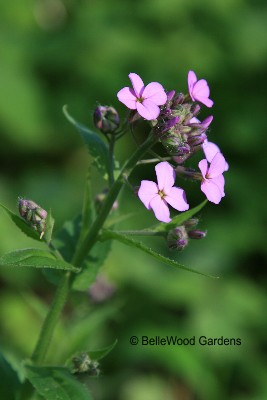
along the side of the road. Dame's rocket, Hesperis matronalis, is a
naturalized non-native that originated in Southern Europe to Siberia. It seeds
about, the sweetly fragrant flowers shading from lilac to white. If you grow it,
do dead-head as the flowers fade, lest it become an invasive nuisance.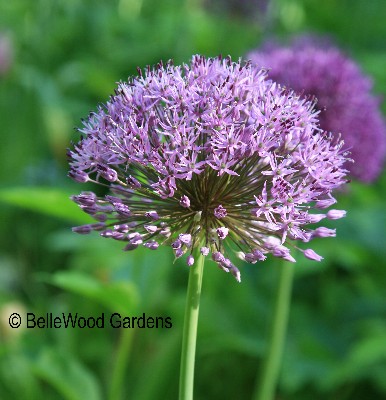
This week the flowers are at peak bloom. I do like it, with
the tight globe of flowers perched on the stem, an arrangement
that botanists refer to as an umbel. Dandelion seedheads too.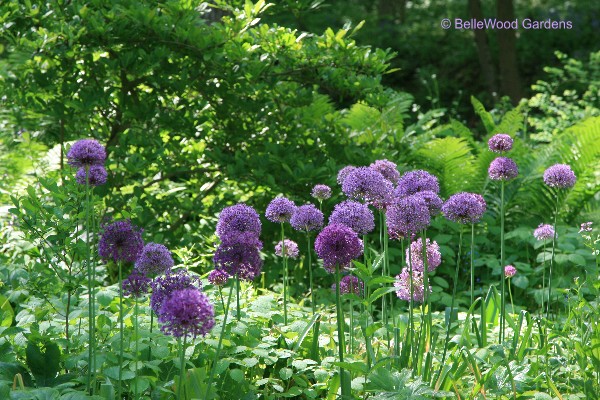
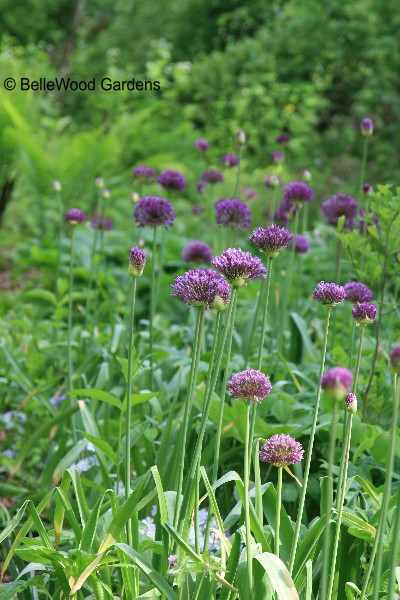
Netherlands Flower Bulb Information Centre sent me some bulbs
to welcome me to my new garden. Among them were these sweet
Allium 'Purple Sensation'. Fifteen years later and each May
they're still performing, reminding me of the beauty of friendship.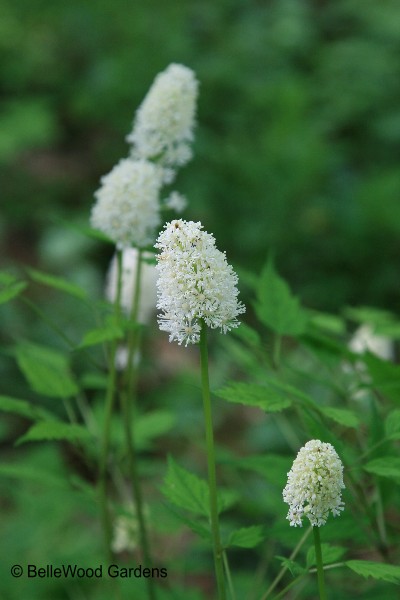
bottle bush blooms of Actaea alba are less than stupendous. In autumn
they'll show why they have the common name of doll's eyes, when their fruits
appear, - white berries, each with a little black dot that provides
the resemblance to the eyes of old-fashioned china dolls.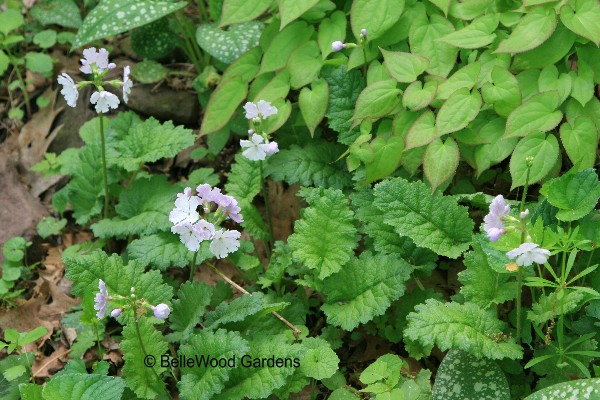
who botanized in Japan, back in the days when Western countries were mostly
kept away. He introduced many plants into Europe, and his name commemorates
the connection. As here, with Primula sieboldii. An elegant woodland species,
be warned - it goes summer dormant, down to a resting bud. Not dead, just
sleeping until next Spring and its return with charming flowers and attractive leaves.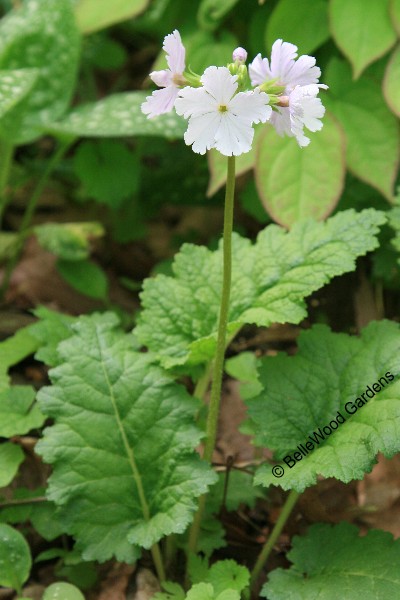
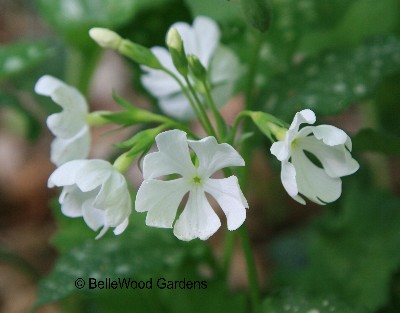
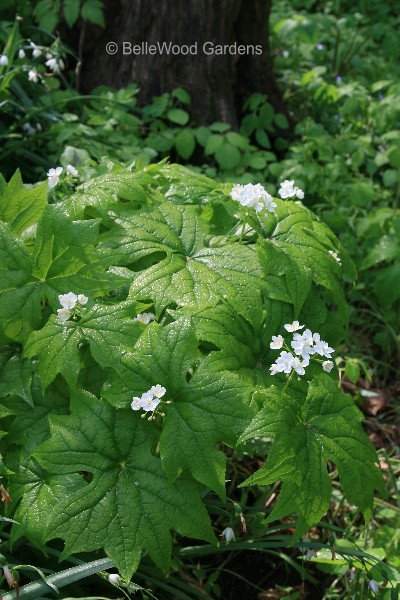
attractively in bloom. I remember planting it, but could not recall its name. Scrabbling
in the leaf litter beneath the handsome foliage didn't help, as there wasn't any
label to assist me. I think this is the first Spring it has flowered. Who is it?
Might it be something with the species name of grayii? Not that that
would be of much help. But then, from the nether recesses of memory came
floating into conscious thought Diphylleia cymosa. Yes! That's its name.
Now to make a sturdy, permanent label, using an indelible marker.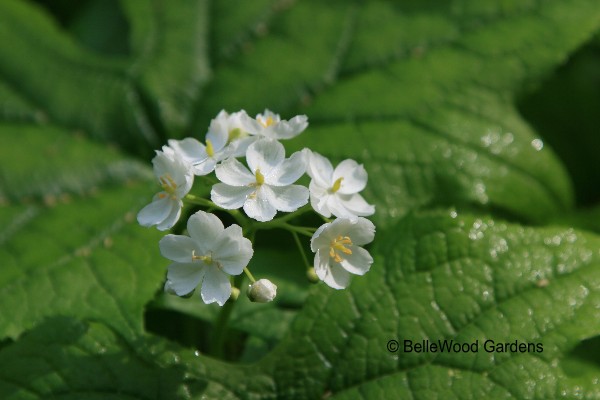
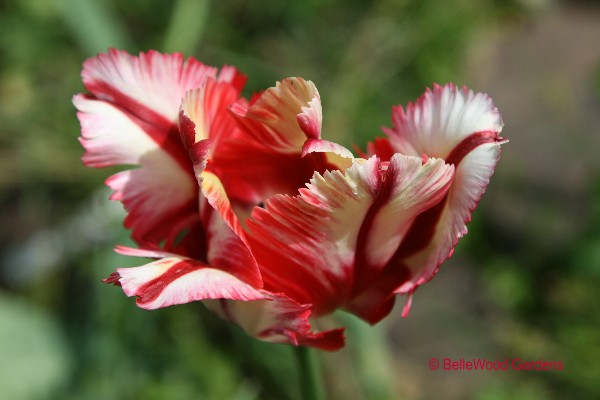
My favorite is fire engine red and white 'Estella Rijnveld'. Isn't she a beauty!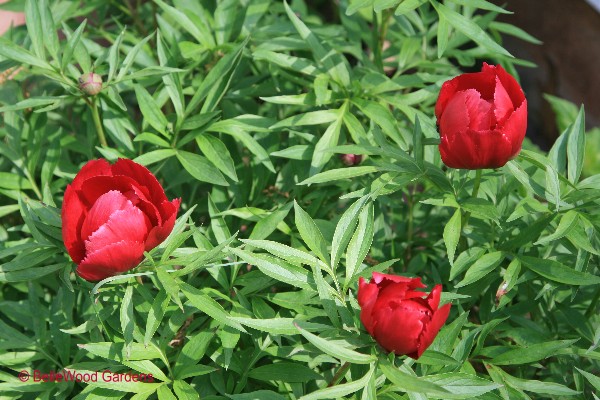
is more substantial than that of the thread-like leaves of Paeonia tenuifolia,
one of its parents. Though it is the bull's blood red flowers that hold my attention.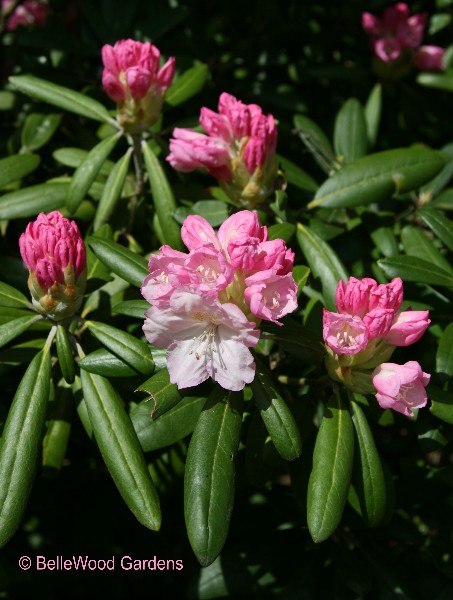
of its polished, dark green leaves. That is, no doubt, the reason deer leave
it alone. Clusters of deep pink buds open to apple blossom pink flowers.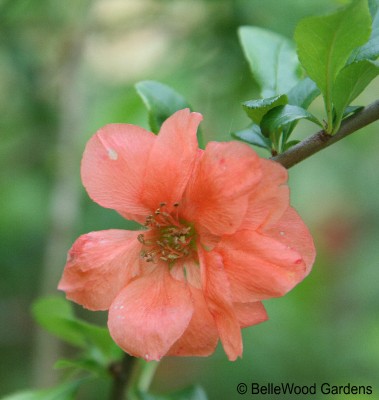
of pleasing soft apricot-coral. More attractive, and easier to find plants with which
it will pleasingly partner. Easy to grow, little troubled with pests, and not an azaleas
(which are beginning to massively flower in fuchsia, hot pink, purple.)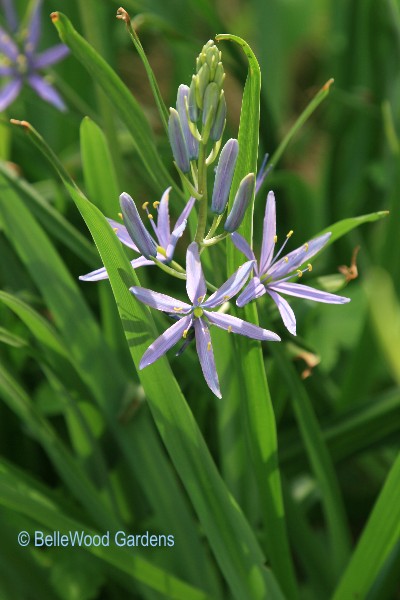
Lewis and Clark that camassia bulbs are good to eat. The indigenous people
were so fond of it that battles would be fought over gathering rights at
the wet meadows where goodly numbers could be found. I only wish
that the attractive flowers would stay in bloom somewhat longer.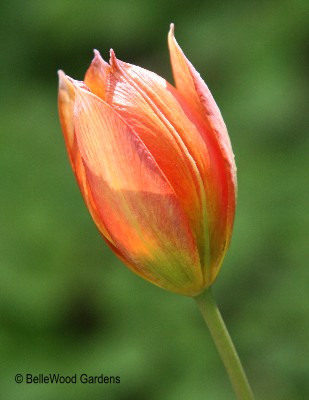
its dull red petals here illuminated by morning sun. It's been in the garden for
several years, perhaps moving a bit here and there (or should I blame
the squirrels?) No matter, it adds a welcome foil to Spring's tender greens.
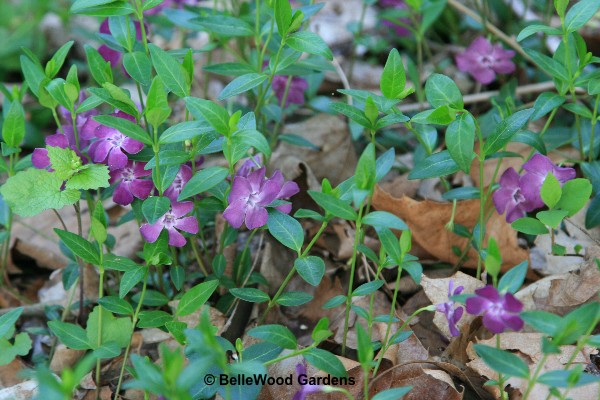
Polished dark green leaves and light lavender flowers are the standard.
Vinca minor 'Bowle's Variety' is one of the available variations, with
larger, rich purple flowers. I have a couple of others, and plan to look for more.
and education specialist and blogger at Midwest Groundcovers. He wrote:
"I do not think your picture of Vinca Bowles Variety is right.
It looks more like Vinca minor 'Atropurpurea'.
Thank you, Kevin. I've not only made the correction here,
but have also renamed the photo to prevent future errors.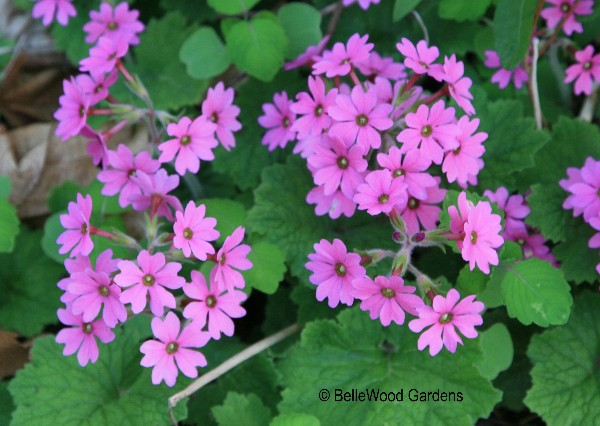
of thread-like runners just below the soil's surface, popping up new plantlets
at their end. Fuzzy leaves, vivid pink flowers make a great addition to Spring.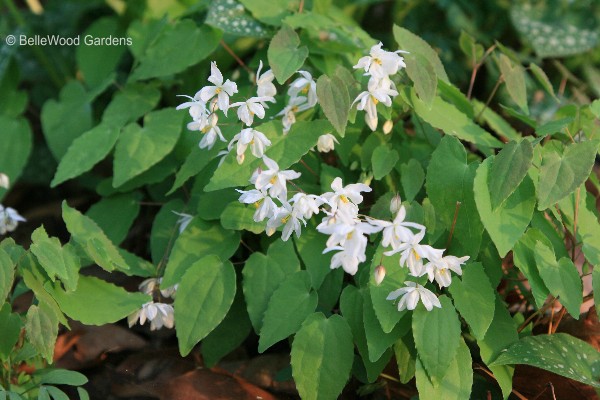
"honorary natives." Epimedium youngianum 'Niveum' surely qualifies.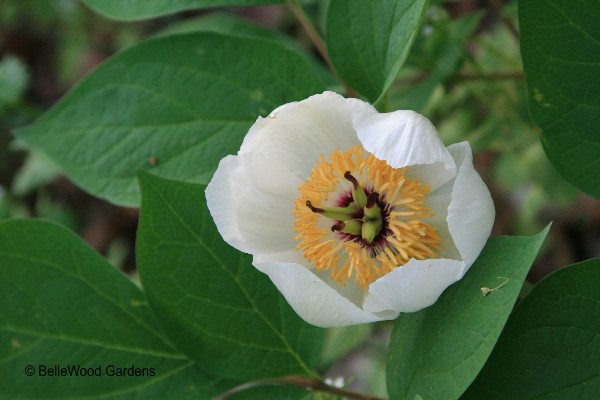
on easy care, long-lived plants. There are two Japanese species for the shade.
Looking at the pointed tips to the leaves I've decided it is Paeonia japonica.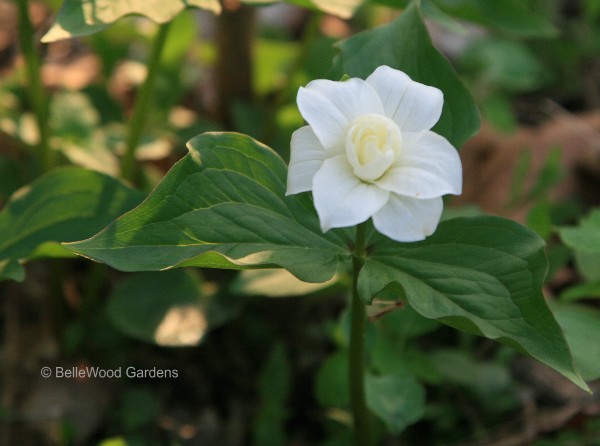
attractive, and (most of them) easy to grow. Here's one
that gardeners all covet, whether they love wildflowers or not. It is
'Flore-pleno', the double form of Trillium grandiflorum. I was given
my first division decades ago by John Osborne, my mentor. It lived
in a cold frame on his property for another year before he could
bring himself to physically part with it. John is long since gone,
but I have our shared memories. And the trillium he gave me.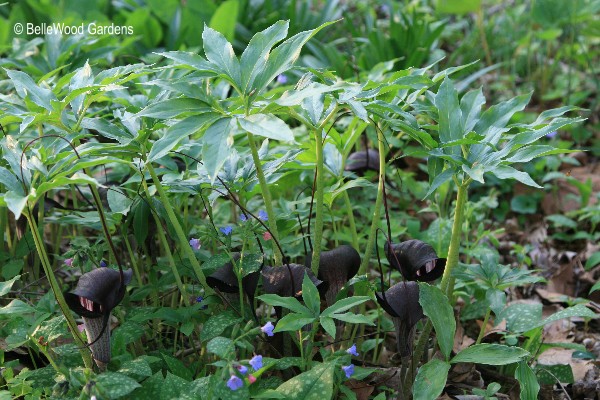
more species of trillium, they have more species of arisaema. One that I am very fond of is
Arisaema thunbergii, with its dark chocolate hood and fishing line extension on the spadix.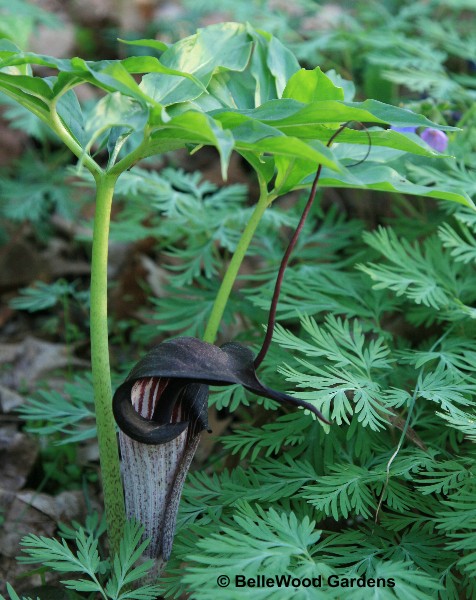
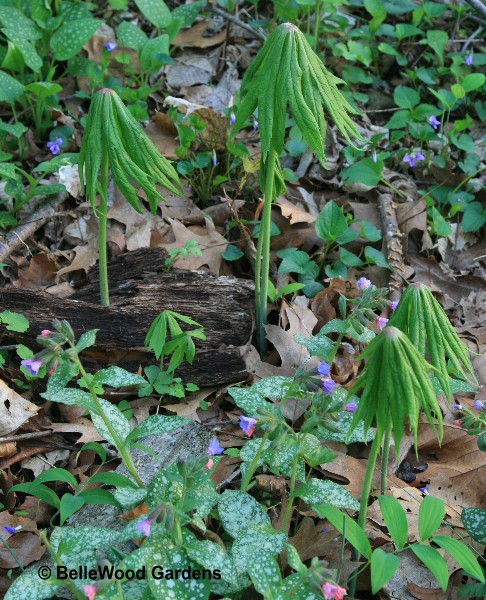
this plant's Japanese name, means "broken umbrella" because
it comes up with folded leaf when it emerges in the Spring woods.
Syneilesis palmata, its Latin name, is not terribly appealing.
I do like its amusing appearance and gently spreading habit.
"The name Yaburegasa is perfect. How clever! As you know it means broken umbrella.
The plant is exactly the shape of old Japanese umbrella. It was made from bamboo and wax paper
and was called janome. Because of the material it can't be tightly closed and bulky,
just like this plant. This plant is perfect janome umbrella and ready to open (broken)."
April
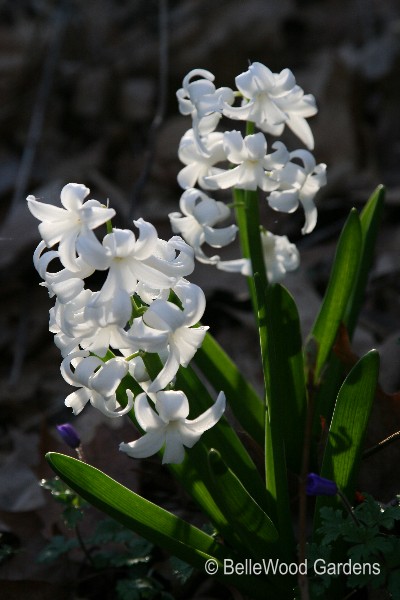
I much prefer them in subsequent seasons, when they have more grace.
Don't recall if this is 'Carnegie' or 'L'Innocence'. Regardless, it's charming.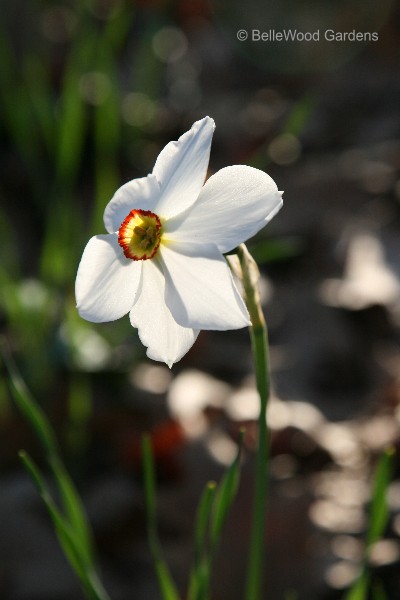
that all its offspring in Division 9 are stamped with its good looks:
white petals and a dainty ruffle of a cup banded red / yellow / green.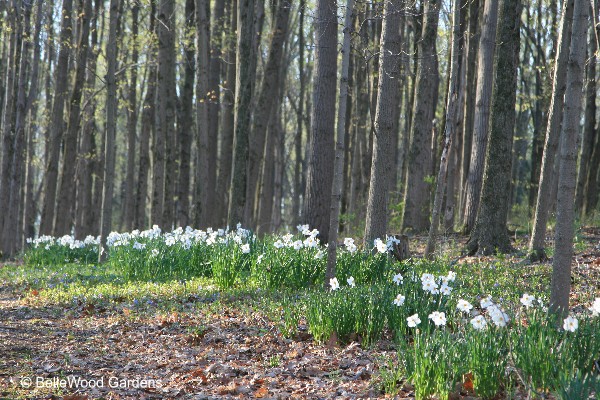
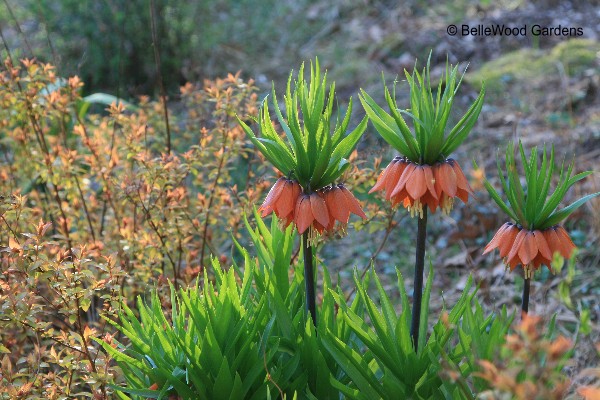
That's rather odd, as I have it on a slope with heavy clay-loam soil and in less
than full sun. The colonies have been here for years, blooming each spring
and busily making offsets. Much to my husband's dismay. He really dislikes
the skunk-like aroma wafting on the wind from bulb, stem, leaf, and flower.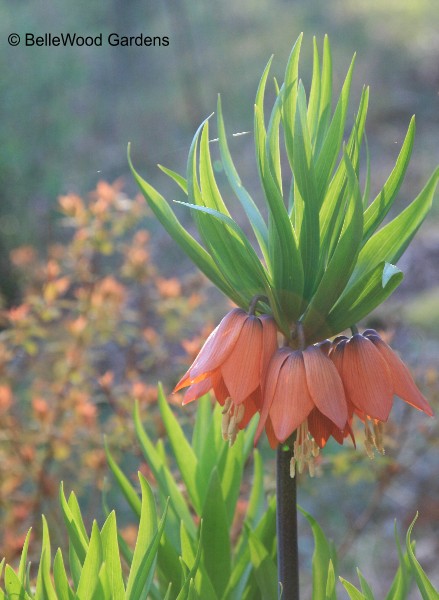
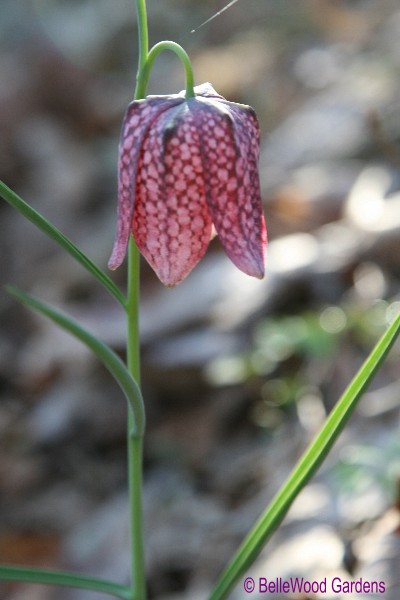
The tessellated patterning of the flowers is said to resemble a Roman centurion's
dice cup. Couldn't really say. But I do find the flowers charming, both dark
and the white with faint green markings variant that occasionally appears.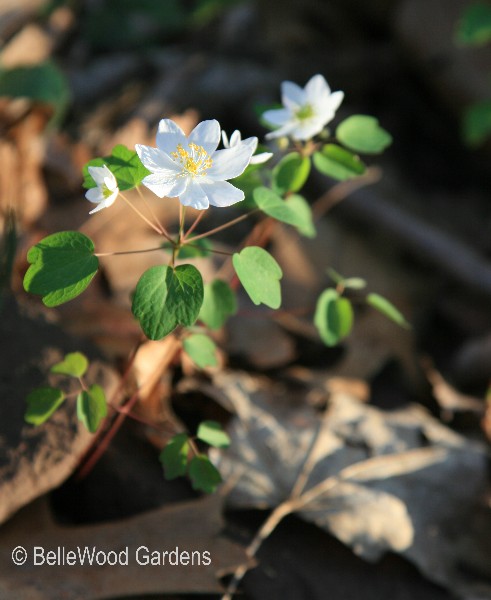
tuberous, cormous) and the herbaceous perennials such as this dainty
Anemonella thalictroides rue anemone. The species name refers to
its foliar resemblance to the leaves of Thalictrum. See, Latin does
convey helpful information. If, that is, you know whereof it relates.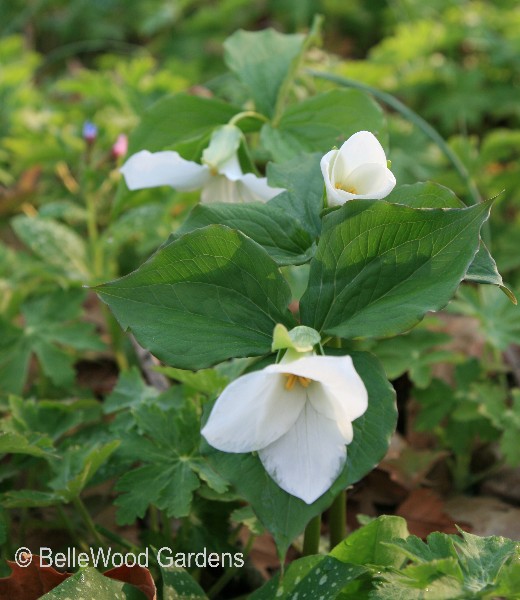
this beautiful Trillium erectum 'Album', the white form of typically ox-blood red
locally native species. In the United States we have two types of trillium: pedunculate,
with a short peduncle or stem-like structure between flower and foliage, and
sessile, where the flower sits right down on the leaves. Sessile trillum
have mottled markings on their leaves and the flowers never open widely. 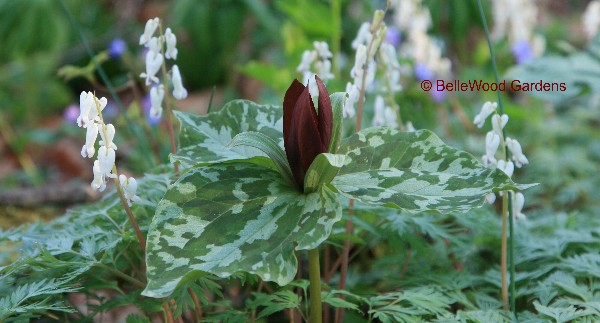
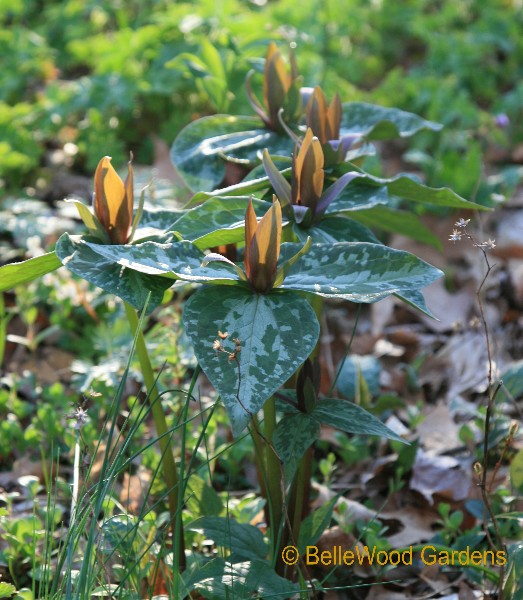
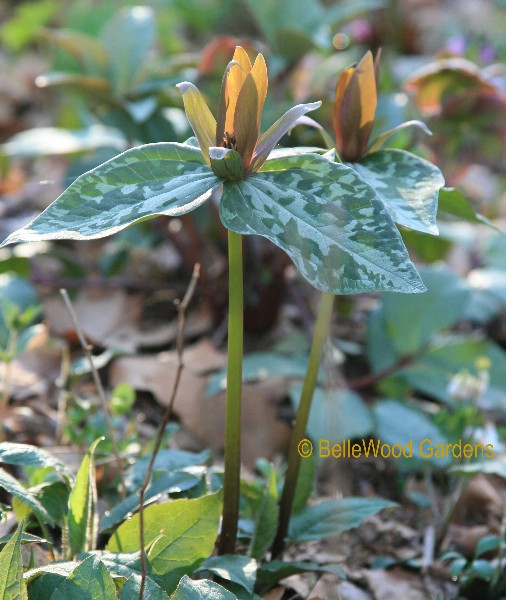
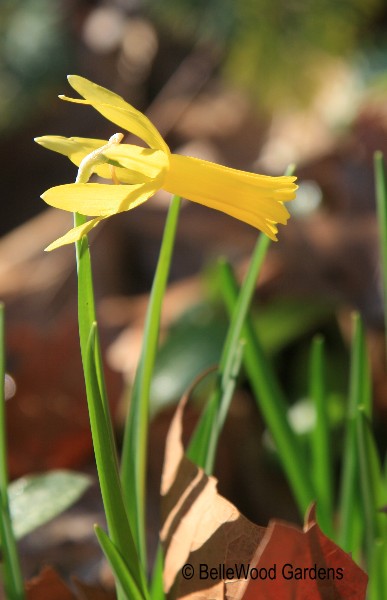
it stamps on its progeny. All narcissus in Division VI, cyclamineus daffodils
exhibit flared back petals. Popular cultivars include 'February Gold',
'Jack Snipe', 'Jenny', 'Peeping Tom', and 'Téte-a-Téte'.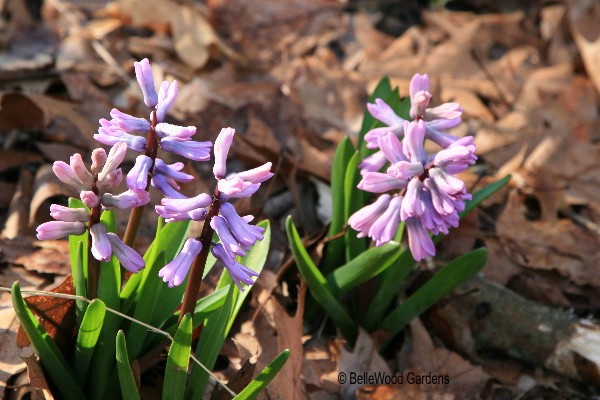
"Oh no! Here she comes with a shovel, again." Really though,
don't you agree that these pink hyacinths should be moved across
the driveway so they can consort with this rosy pink star magnolia.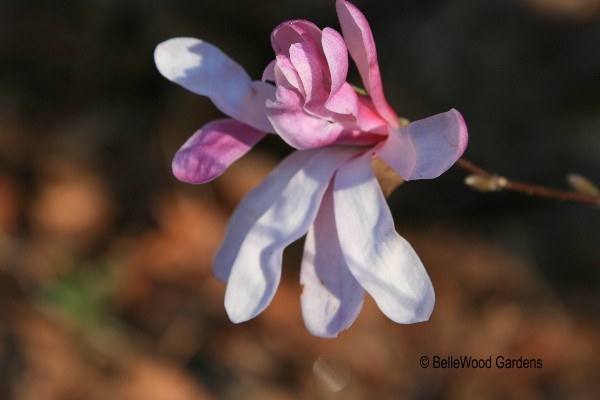
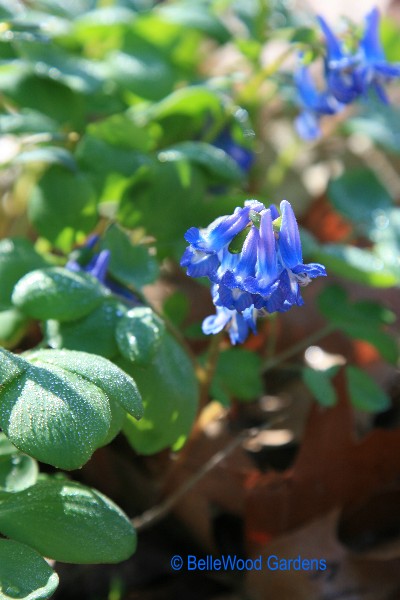
Problem was, it turned out that they were difficult to satisfy and alas,
quickly disappeared. I've got this one, which is still with me. Flowers
every Spring, increasing very slowly - by offsets I think.
Don't quite have the nerve to go excavating lest I cause some
inadvertent damage. No seedlings have ever shown up. I sure
would like to have more. You can agree with that sentiment, yes?
If it had a label, if I kept better records, well, then I'd know its name.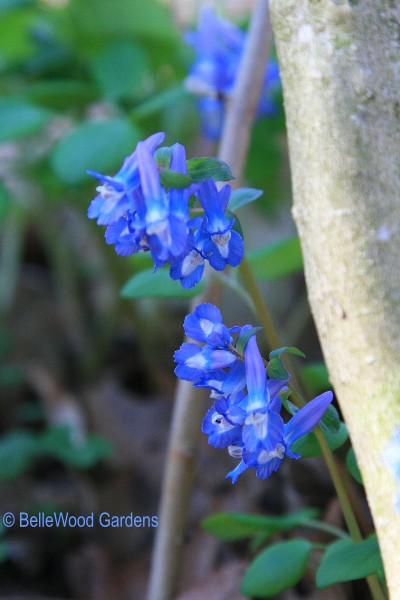
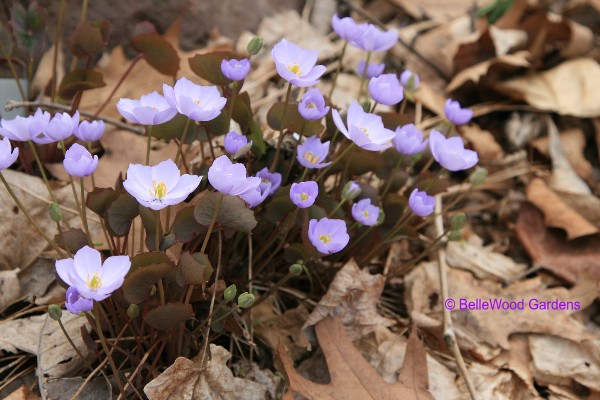
and Manchuria. Easy to grow, difficult to propagate. Only smaller plants are willing
to be moved around the garden, and seed insists on self-sowing, germinating poorly
in a pot. I'm very fond of the soft lavender flowers and copper hue of the young leaves.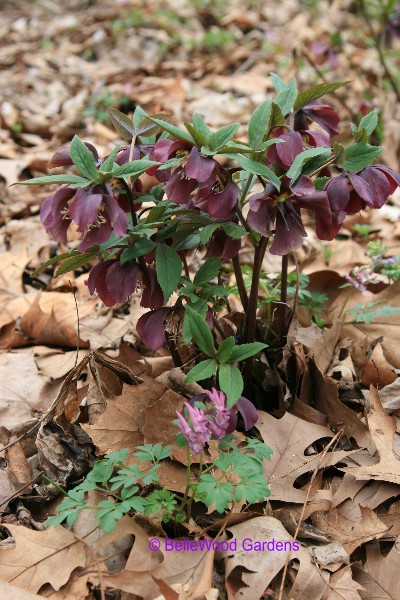
fumewort, Corydalis solida. The ferny leaves quickly disappear, but a zillion seeds
lay waiting to germinate next Spring. Small, dainty, fumewort has a rugged constitution.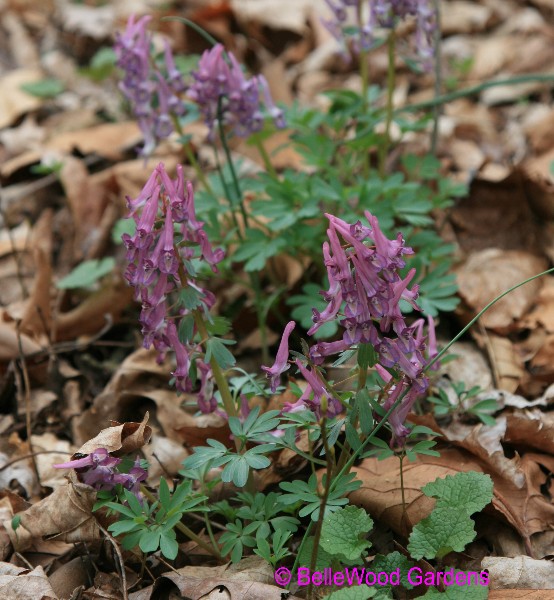
with deep ox-blood buds that fade as they open to delicious pink-veined creamy white flowers.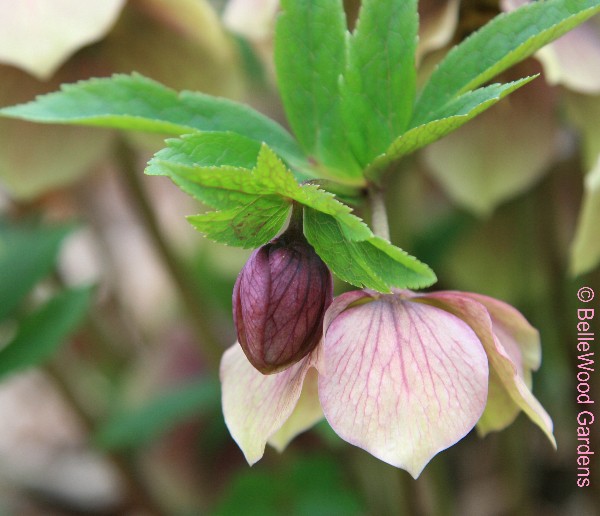
to leave them alone for a couple of years. Some will be lost to attrition due to overcrowding.
But I'll lose many more if I move them as infants. Patience is also important in gardening.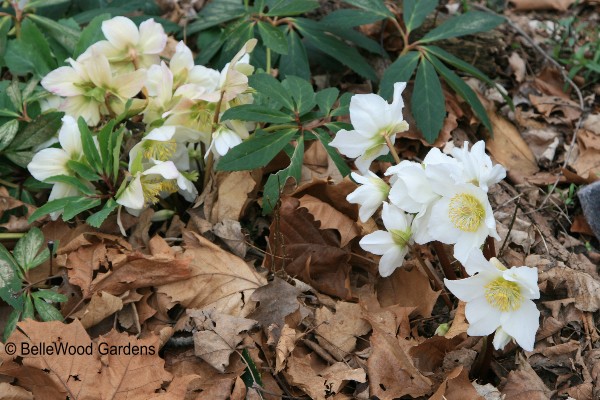
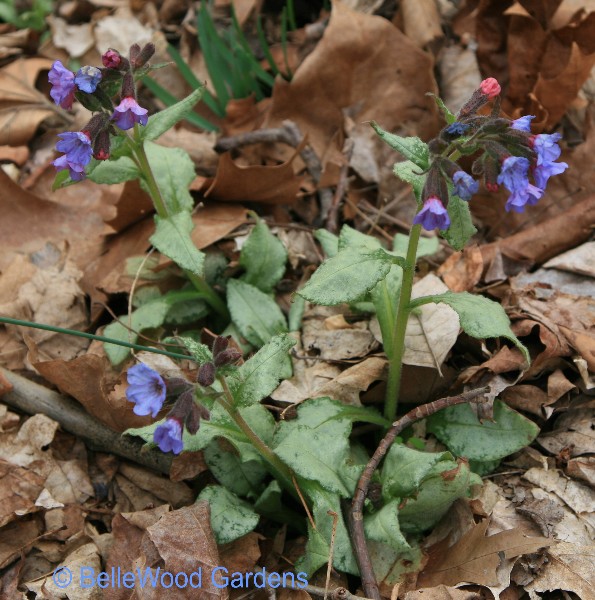
Once established, it tolerates dry shade. Fuzzy leaves are unpalatable to deer.
Leaves are evergreen. And oh yes, the flowers are attractive too. There are
several all-silver cultivars such as 'Cotton Cool', 'Excaliber' and 'Majeste'.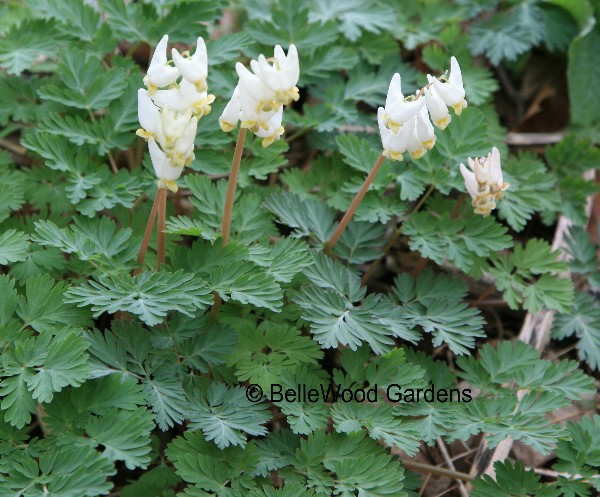
Dutchman's breeches, Dicentra cucullaria is a true bulb that like the more familiar
"Dutch" bulbs of Spring (daffodils, hyacinths, snowdrops and such-like) will also
quickly disappear soon after flowering. Ephemeral is one term, fugacious another.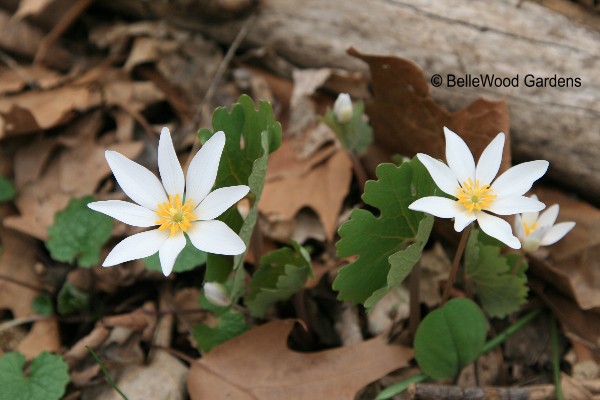
refer to the orange-red sap that oozes from damaged leaves, stem, or tuber.
It is another case where common and Latin names mean much the same thing.
Lungwort and Pulmonaria also. But I digress. Bloodroot flowers are short-lived,
only a week or so. The bold leaves stay all summer, an attractive companion
for ferns and other lacy leaved plants like astilbe, or linear, strap-like sedges.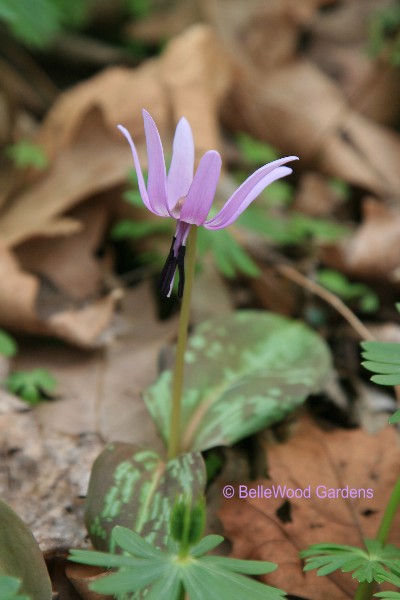
a pretty in pink Erythronium dens-canis variety japonicum.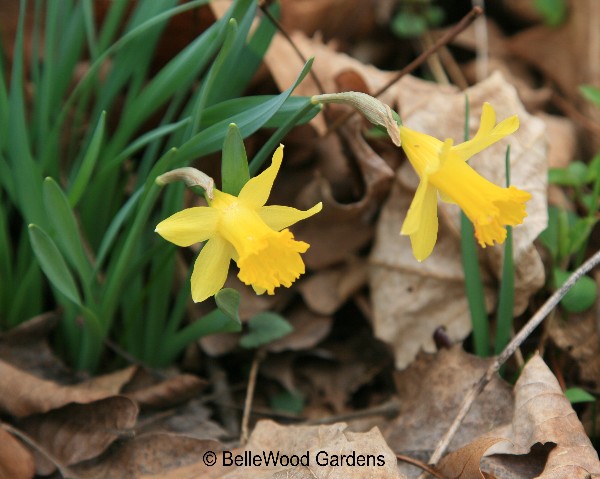
became lost in our travels but 'Mustard Seed' comes to mind. The description fits
but I've yet to find a picture. Oh well, it knows who it is. Even if misidentified
I like its placement near Jeffersonia dubia for a striking combination of colors.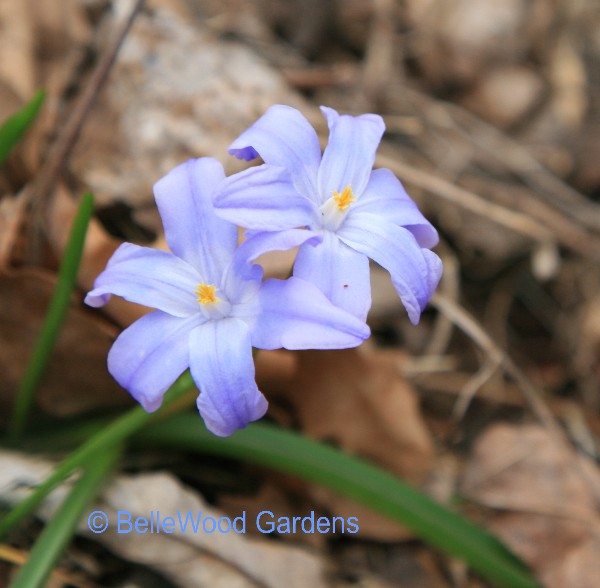
I'm referring to color, all the little bulbs in wonderful shades of blue. Like this
Glory of the snow, Chionodoxa luciliae with soft violet-blue flowers.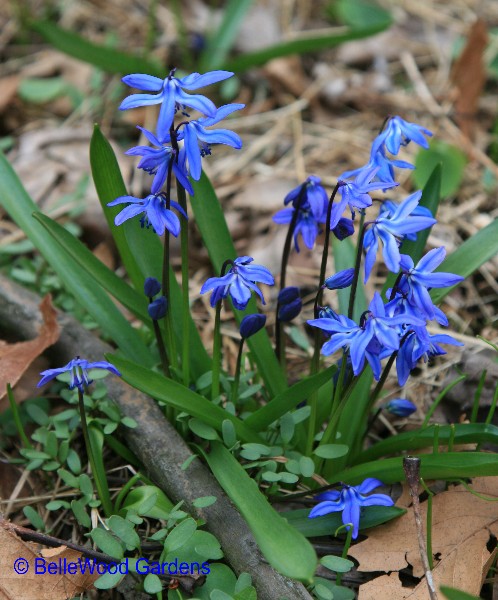
it appears to glow on the overcast day when I took this picture.
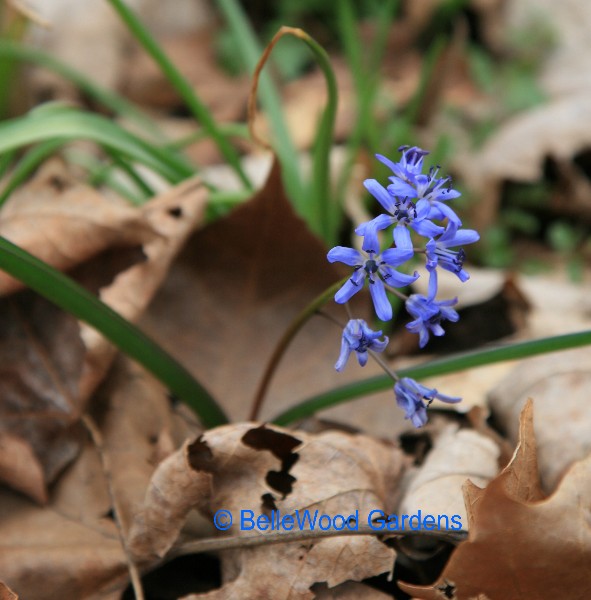
It bears a one-sided raceme of small, starry blue flowers. Beware the pink one.
Pink in bud, barely, and a nothing better than muddy off-white when in bloom.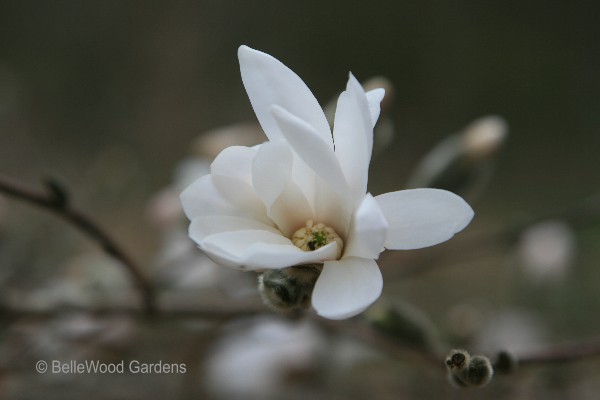
a flower open here and there, as furry-coated buds begin to swell and open.
March
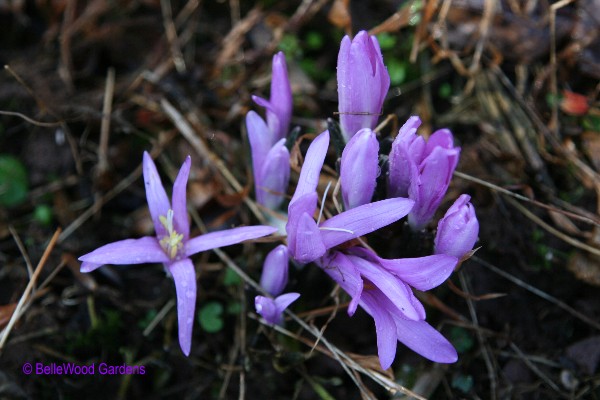
Related to Colchicum and Merendera, the difference is only
that its style is twice cleft into 3 lobe-like parts. Cormous, it resembles
a smaller version of colchicum's, with brown tunic & protruding little "foot".

browsing BelleWood Gardens for a snack.
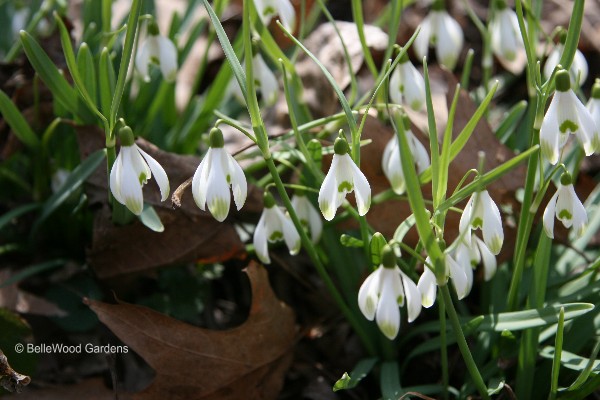
at the tips of its outer petals. Discovered in the Van Tubergen nurseries sometime
around 1920, it may be found in catalogs under several invalid cultivar names:
'Viridapicis', 'Virid-apice', or as Galanthus nivalis variety viridapicis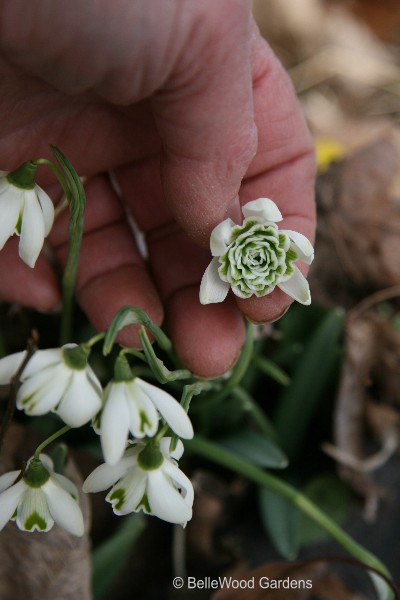
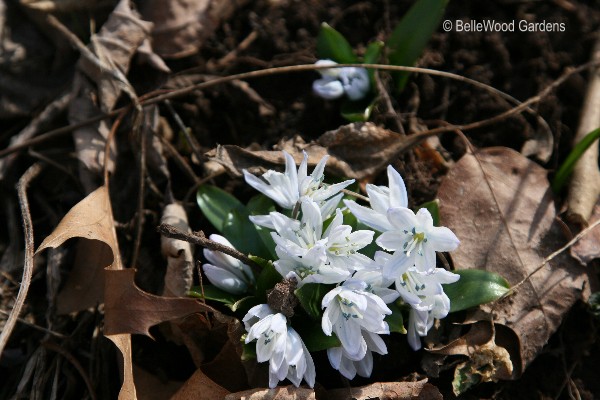
to both spell and pronounce. Not any longer. It now rejoices in Scilla mischtschenkoana.
I feel like saying "Did the cat sneeze? Geshundteit." Regardless of what we name it,
this pretty little scilla has petals separate to the base which makes it easy to distinguish
from the look-alike Pushkinia scilloides. So eager to bloom that flowers begin to open
when scarcely above ground, the color of skim milk with a turquoise line down each petal's center.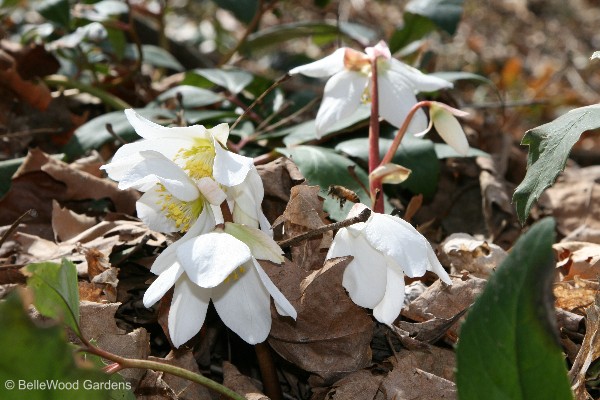
this herbaceous perennial is lumbered with the common name of Christmas rose.
The specific epithet of its Latin name, Helleborus niger, refers to the black color of its roots.
Not especially handy / dandy when you are walking around the garden sans shovel.
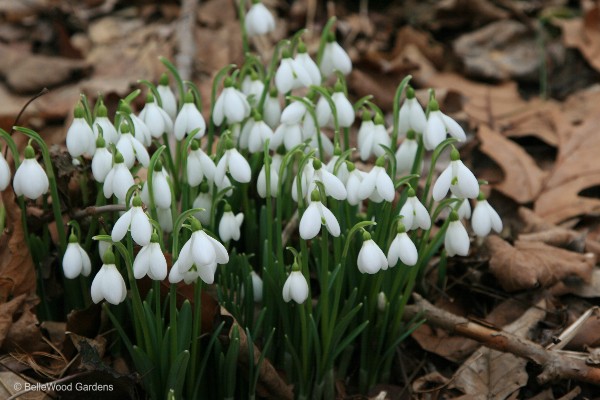
they're perce-niege, or snow piercer in French. An old Flemish name,
lichtmisbloem, refers to a medieval ceremony where snowdrops
were scattered around a statue of the Virgin at Candlemas, in February.
Snowdrops first appeared in an illuminated manuscript in the Bourdichon
Book of Hours created for Anne of Brittany in the early 16th century. 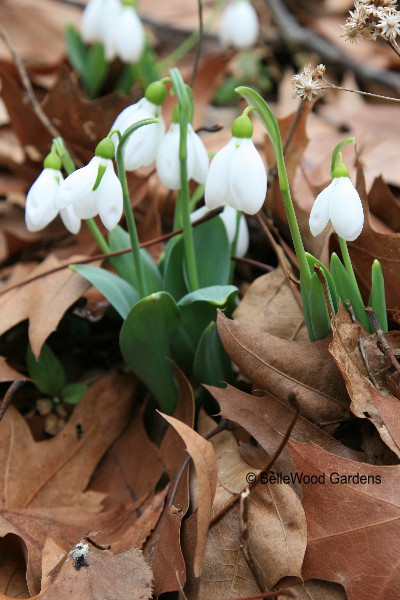
reveals their details. Here, Galanthus elwesii has broad glaucous leaves
and flowers with a second band of green at the base of the central tube
that - in this clone - merges with the green at the sinus or opening
so all the length of the tube is a clean bright green.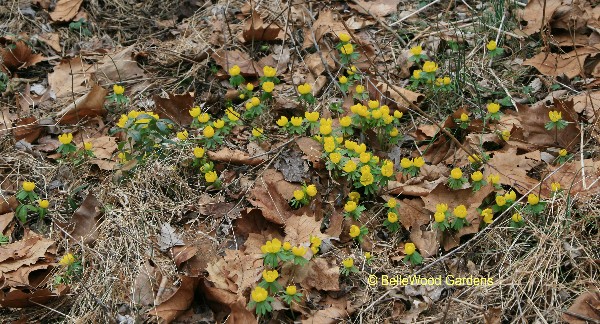
over winter-barren ground. Difficult to grow when one begins with desicated tubers
purchased in autumn, once established it happily reseeds with generosity. And
a trowel's worth, lifted as flowers fade but while leaves are yet green move with ease.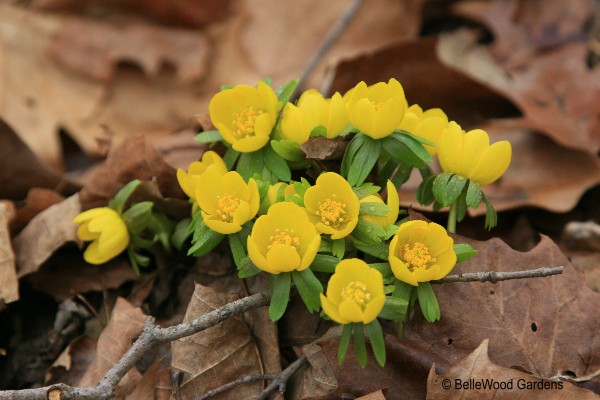
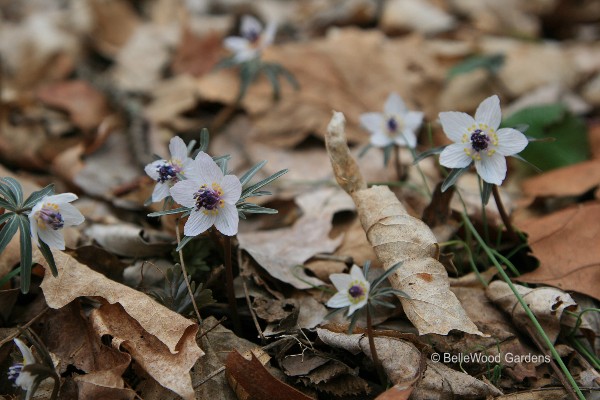
fresh seed from his garden, cautioning me to sow it where the plants would grow,
as they transplant poorly, if at all. I took heed of his advice, and each Spring
think of him when the ethereal white flowers with golden crown of stamens
briefly appear and enchantingly embellish BelleWood Gardens.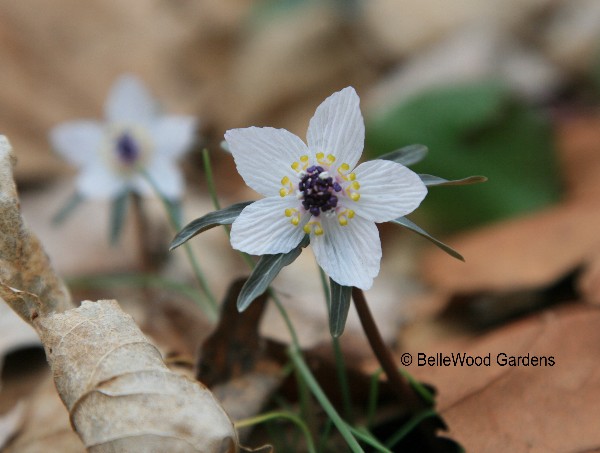
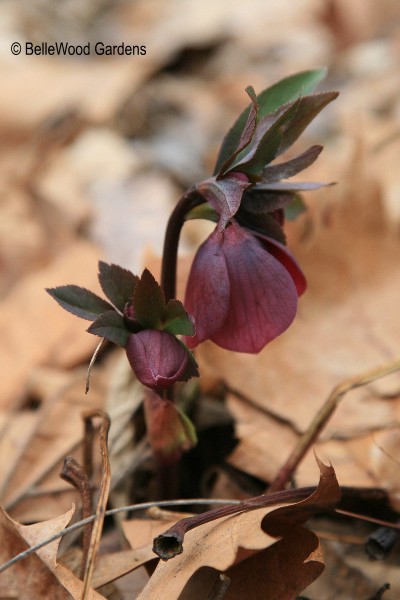
Helleborus Early Purple Group moved with me from
Connecticut over a decade ago. They do not seem to seed
about and I tend to leave them undisturbed, but suppose
I could dig and divide - were there sufficient hours
in the day when Spring's frenetic chores all arrive.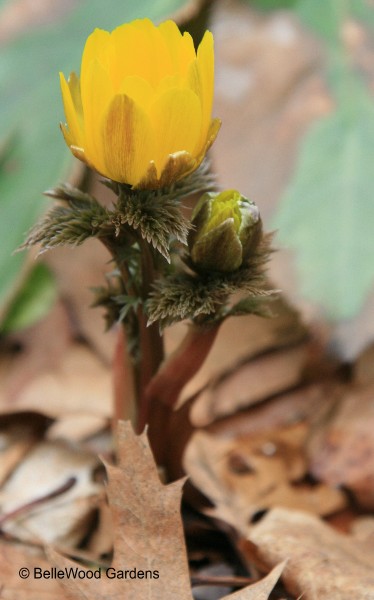
surmount bronzy fern-like foliage. To dig and dissect, cut apart
the tangled mass of thong-like black roots is not for the faint-hearted.
Perhaps I'll just leave them be for another year . . . .
